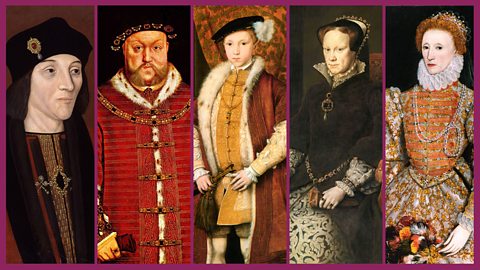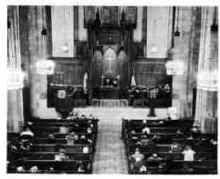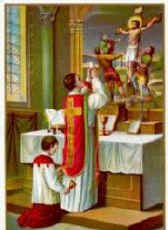The Tudors are one of the most remarkable dynasties in English history. Henry VII, of Welsh origin, successfully ended the Wars of Roses and founded the House of Tudor. He, his son Henry VIII, and his three children Edward VI, Mary I and Elizabeth I ruled for 118 eventful years.
Click here to see more posts in this category. Scroll down to see more articles about the history of the Tudors.
The Tudors – The Six Wives of Henry VIII
Catherine of Aragon, Anne Boleyn, Jane Seymour, Anne of Cleves, Kathryn Howard, Katherine Parr
Divorced, beheaded, died; Divorced beheaded survived
This popular rhyme tells of the fate of Henry VIII’s six wives
 |
Catherine of Aragon – Henry VIII’s first wife and mother of Mary I
Catherine was the youngest daughter of Ferdinand and Isabella of Spain and she came to England in 1501 at the age of 16 to marry Henry VII’s eldest son and heir to the throne, Arthur. By 1527 Henry was having serious doubts about his marriage to Catherine. He believed that he had no sons because God was punishing him for having married his brother’s wife. He had found a passage in the Bible that backed this belief. He had also fallen for Anne Boleyn, the daughter of Thomas Boleyn, who had recently returned to England from the French court. Catherine refused to grant Henry a divorce or retire to a convent. Henry therefore began the Reformation in England so that he could divorce Catherine without the Pope’s permission and marry Anne Boleyn. Catherine was divorced by Henry in 1533 and died in 1536.
|
|||||||||||||||||||||||||||||||||||||||||||||||||||||||||||||||||||||||||||||||||||||||||||||||||
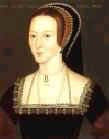 |
Anne Boleyn – Henry VIII’s second wife and mother of Elizabeth.
Anne Boleyn was born in 1501. At the age of fourteen she was sent with her sister, Mary, to the French court as a maid to Queen Claude. She returned to England in 1522 and attracted many admirers. Her sister, Mary managed to attract the King’s attention and became his mistress. In 1526 Henry asked Anne to become his mistress, but she refused because he was a married man. Henry was determined to win Anne Boleyn and became determined to divorce Catherine and marry Anne. The couple eventually secretly married in 1533 after Anne became pregnant. The King’s second marriage was not popular. Many people believed that Anne was a witch and had cast a spell on Henry. When the baby was born in September 1533 Henry was cross that the baby was a girl. She was called Elizabeth. Henry and Anne began arguing. Although Anne became pregnant twice more each time the babies were stillborn. Henry was by now tired of Anne and wanted rid of her. He had no intention of waiting for a divorce so his ministers invented evidence showing that Anne had been unfaithful and had plotted the death of the King. She was found guilty and was executed in May 1536.
|
|||||||||||||||||||||||||||||||||||||||||||||||||||||||||||||||||||||||||||||||||||||||||||||||||
 |
Jane Seymour – Henry VIII’s third wife and mother or Edward VI.
Jane Seymour was a quiet shy girl who attracted Henry because she was so different to his first two wives, Catherine and Anne. Henry married Jane Seymour just 11 days after the death of Anne Boleyn. He was 45 years old, Jane was 28. Although Henry became concerned when Jane did not become pregnant immediately, he was delighted when she gave birth to a son, Edward, in October 1538. Henry was very upset when Jane died a month later. On his deathbed, Henry requested to be buried next to Jane.
|
|||||||||||||||||||||||||||||||||||||||||||||||||||||||||||||||||||||||||||||||||||||||||||||||||
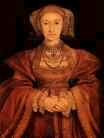 |
Anne of Cleves, Henry VIII’s fourth wife. She was divorced after six months.
After the death of Jane, Henry remained single for two years. He had the son that he had wanted for so long and although Edward was weak and sickly, he continued to live. Having broken free from Rome in the 1530s England was isolated from much of Europe and Henry’s advisers thought it would be a good idea for him to marry a German princess and make an alliance with the other great Protestant nation in Europe – Germany. Two suitable princesses were chosen and Hans Holbein was sent to paint their portraits. The girls were sisters and daughters of the Duke of Cleves. Henry chose the older daughter, Anne, to be his fourth wife. The 24 year old German Princess arrived in England in December 1539, However, Henry was horrified when he saw her and demanded that his ministers find him a way out of the marriage. Unfortunately for Henry they could not and the marriage went ahead in January 1540. Henry was unable to consummate the marriage and the couple divorced amicably six months later. Anne was well provided for and lived out her days in England in comfort. She outlived Henry and died in 1557. |
|||||||||||||||||||||||||||||||||||||||||||||||||||||||||||||||||||||||||||||||||||||||||||||||||
Loading... Loading... | ||||||||||||||||||||||||||||||||||||||||||||||||||||||||||||||||||||||||||||||||||||||||||||||||||
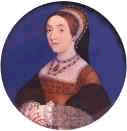 |
Kathryn Howard, Henry VIII’s fifth wife. She was executed for adultery after two years of marriage.
Henry had chosen his fifth wife before his divorce to Anne was finalised. The lady in question was the 15 year old daughter of Edmund Howard, Kathryn, cousin of Anne Boleyn. The marriage took place in July 1540. Henry was 49 years old, overweight and unable to walk far due to his weight and an injury to his leg that festered and refused to heal. Kathryn was young, lively and flirtatious. She was bored with having an old husband and sought out young friends among the courtiers. Unfortunately for Kathryn one of the courtiers in question was a man named Francis Dereham who had known Katherine before her marriage. He knew that she had had affairs before her marriage and used this to bribe her into giving him a good position at court. Katherine’s actions led to her being accused of adultery and subsequently executed in 1542. |
|||||||||||||||||||||||||||||||||||||||||||||||||||||||||||||||||||||||||||||||||||||||||||||||||
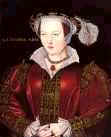 |
Katherine Parr Henry VIII’s sixth wife. She outlived Henry and died in 1548.
Henry married for the sixth time in 1543. The lady in question was Katherine Parr who had been twice widowed. She was a kindly lady and proved a good stepmother to the King’s three children. She was also an excellent nursemaid and bathed Henry’s leg wound and comforted him when he was sick. She came close to being tried for treason in 1546 when her enemies at court attempted to prove that she was a committed Protestant. However, she managed to convince Henry that she was loyal to him and his Church and was spared. After Henry’s death she married Edward’s uncle, Thomas Seymour. Katherine Parr died in childbirth in 1548. |
|||||||||||||||||||||||||||||||||||||||||||||||||||||||||||||||||||||||||||||||||||||||||||||||||
Tudors and Stuart Timeline
The Tudors and Stuart Monarchs and some of the main events of their reigns
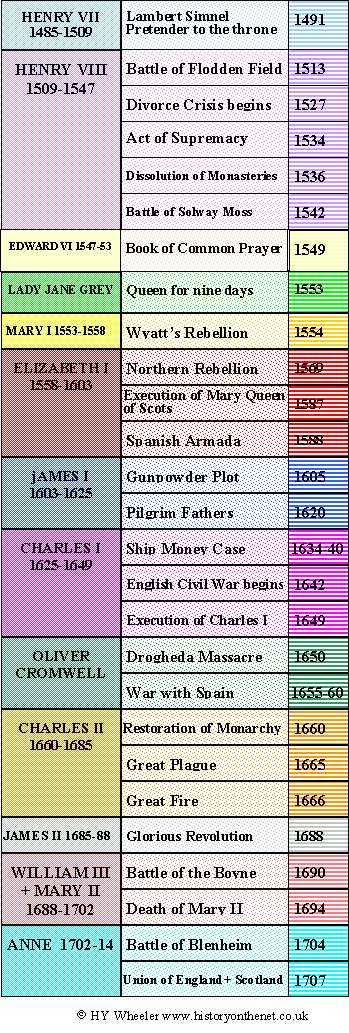
Timeline – The Tudor and Stuart Monarchs
A detailed Timeline showing the Tudors and Stuart Monarchs and some of the main events of their reigns.

The Tudors – Tudor and Stuart Timeline
The Tudors and Stuart Monarchs and some of the main events of their reigns.
The Tudors – Elizabethan Poor Law 1601
Before the Reformation it had always been considered Christian duty to carry out the instructions laid down in Matthew chapter 25 – that all Christians shall:
- Feed the hungry
- Give drink to the thirsty
- Welcome the stranger
- Clothe the naked
- Visit the sick
- Visit the prisoner
- Bury the dead.

After the Reformation, many of these values disappeared and the poor were left without help. It became increasingly clear that something had to be done to help those who were genuinely in need, and something else had to be done about the increasing numbers of those who chose to beg and steal rather than work.
In 1552 Parish registers of poor were introduced. This meant that there was now an official register of poor in a parish.
In 1563 Justices of the Peace were given the power to raise funds to support the poor. Categories were also drawn up for the different types of poor and beggars that were found on the streets.
Deserving Poor This category was for those people who wanted to work but were unable to find suitable employment. These people were to be given help in the form of clothes, food or maybe money. (Outdoor Relief)
Or
Those who were too old, young or ill to work. These people were to be looked after in almshouses, orphanages, workhouses or hospitals. Orphans and children of the poor were to be given an apprenticeship to a tradesman. (Indoor Relief)
Undeserving Poor Also called idle beggars or sturdy beggars, this category was for those who could work but chose not to. They were to be whipped through the town until they learnt the error of their ways.
In 1572 it was made compulsory that all people pay a local poor. The funds raised were to help the deserving poor.
In 1597 It was made law that every district have an Overseer of the Poor. The overseer had to do the following things:
- Work out how much money would be needed for the numbers of poor in that district and set the poor rate accordingly
- Collect the poor rate from property owners
- Relieve the poor by dispensing either food or money
- Supervise the parish poor house
In 1601 An act of Parliament called The Poor Law was passed by Parliament. The Act brought together all the measures listed above into one legal document.
The Tudors – The Spanish Armada
Background
Shortly after Elizabeth’s accession to the throne of England, in 1559, a peace treaty was signed between England, France and Spain bringing peace to Europe.
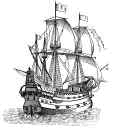
Without the burden of having to pay for a war, England became prosperous and in 1568 Elizabeth used money to increase the size of the navy. The new ships that were built were faster and easier to steer than before.
At the end of the year the English navy seized a treasure ship bound for the Netherlands, which was controlled by Spain. Philip II of Spain was very cross and relations between England and Spain worsened.

Philip was also annoyed that Elizabeth had restored Protestantism in England. His anger with England increased further after Elizabeth knighted Francis Drake. The countries of Europe had an agreement that there would be free trade between them, Drake, however, preferred to trade privately and Philip saw Elizabeth’s knighthood of him as an insult to the free trade agreement and began to prepare for war.
After the Protestant leader of the Netherlands, William of Orange, was assassinated, Elizabeth provided Drake with a navy of 25 ships and told him to harass Spanish ships. The English sailor did as he was asked and took Spanish possessions from Colombia and Florida. Philip retaliated by seizing all English ships in Spanish ports.
Elizabeth allied England with the Protestant Dutch states who wanted freedom from Spain and sent an English army to assist them.
Philip made plans for a fleet of 130 Spanish ships to block the Channel and allow the Duke of Parma to invade England.
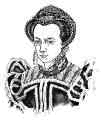
When Elizabeth ordered the execution of Catholic Mary Queen of Scots in 1587, Philip increased the numbers of ships bound for England and planned an invasion force. Once again his plans were upset by Drake who managed to enter Spanish waters and burn large numbers of the ships bound for England.
The Armada set sail from Lisbon on May 28th 1588 but encountered storms and was forced to put in to the port of Corunna to make repairs. It was July 1588 before Philip’s Armada was ready to set sail again.
29th July 1588
The Armada under the control of Medina Sidonia, reached the western approaches to the English Channel. Warning beacons were lit all along the South Coast and the English navy was put to sea.
The English defending fleet, commanded by Lord Howard of Effingham, included ships captained by Drake, Frobisher and Hawkins. Effingham sailed in the ‘Ark Royal’, which had been built for Raleigh in 1581, while Drake captained ‘The Revenge’. However, instead of concentrating all his resources in the straits of Dunkirk as Philip had thought he would, Effingham stationed a large contingent at Plymouth to shield the south-west coast from a direct landing.
The story is told that Drake was playing a game of bowls when the Armada was sighted, but insisted on completing the game before setting sail.
Many of the Armada’s Captains favoured a direct assault on England, but Medina Sidonia’s orders strictly forbade this. The fleet therefore sailed on from the Lizard to Calais to meet the Duke of Parma. However, on reaching Calais, the Duke of Parma was not to be seen. The Armada dropped anchor to await his arrival.
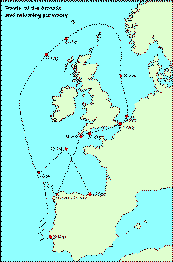
Route taken by the Spanish Armada.
8th August 1588
At midnight, Howard sent eight fire ships into the congested Spanish ranks. Many Spanish Captains cut their cables in their haste to escape the flames. They blundered away from the blaze straight into the gunfire of the waiting English. Unfortunately for the Spanish, their fire power was vastly inferior to that of the English.
A change of wind blew the Armada North out of the range of English fire. However, the wind became a gale and the Spanish were driven further North and many were dashed on the Northern rocks. The survivors were forced to make their way round the Orkneys and down the Irish coast. The remains of the proud Armada limped home to Spain.
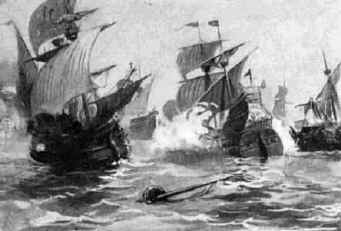
The Defeated Spanish Armada
Recent Research
The defeat of the Armada may not have been due to the superiority of the English. Examination of cannon balls found on the bottom of the North Sea has shown that Spanish cannonballs were not all the same size. Different sizes of gun required different sizes of cannonballs. It has been suggested that the Spanish ships were not equipped with the right cannonballs for the guns on board their ships and were therefore unable to fire on the English ships that attacked them. They therefore chose to retreat, possibly to the Netherlands. The high winds prevented them from reaching port and dashed the ships against the rocks of northern Scotland.
The Tudors – Discoverers and Explorers
In the Tudors period Europeans began to explore the world more than ever before. Some of those who left their homeland and journeyed across the seas were looking for new lands and peoples to trade with, some were looking for better and quicker routes to China and India.
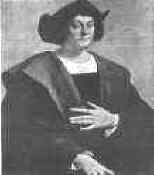
Christopher Columbus (1451-1506) was an Italian explorer who, financed by the king and queen of Spain, set sail to find a new route to India.
He left Europe early in September 1492 and when land was sighted one month later he believed he had found India and named the native people living there, Indians.
Columbus had not reached India as he thought but had reached Central America. He claimed the land for Spain and from 1492 onwards Europeans began to settle in America. They called it the New World.

Ferdinand Magellan (1480-1521) was a Portuguese explorer and the first sailor to sail all around the world.
He did not discover America because he sailed around the bottom of South America.
Magellan also named the Pacific Ocean.
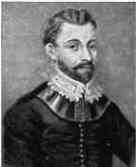
Sir Francis Drake (1545-1596) was a British explorer and navy captain. He was financed by Queen Elizabeth to discover lands and riches for England. Drake was the second man to sail all around the world and was knighted by the queen for his services to the country.
In 1588 he was one of the Captains that sailed to meet and defeat the Spanish Armada. It is a well known legend that he insisted on finishing a game of bowls before going to his ship.
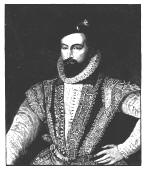
Walter Raleigh (1552-1618) was an adventurer and explorer who became one of queen Elizabeth’s favourites after putting down a rebellion in Ireland. Elizabeth gave him land and the position of captain of the Queens Guard.
Raleigh led an expedition to the New World and claimed North Carolina and Virginia for England. Virginia was named after Elizabeth who was known as the Virgin Queen because she never married.
In the New World Raleigh discovered potatoes and tobacco and brought them back to England.
While Raleigh had been in the New World Elizabeth had found herself a new favourite, Robert Devereux, Earl of Essex.
In 1592 Elizabeth found out that Raleigh had married one of her maids. She was very angry and put him into the Tower of London. When he was released three years later he left England for the New World in search of gold.
Walter Raleigh had always had enemies and after Elizabeth’s death they convinced James I that he did not support the king, a crime punishable by execution. Raleigh was not executed but was sent to the Tower of London where he spent his time writing. It is thought that his unfinished book ‘History of the World’ was written at this time.
In 1616 he was released from the Tower and once again set off to search for gold. However, while on his expedition he destroyed a Spanish town in the New World. The king of Spain was furious and demanded that Raleigh be punished. James decided to use the execution notice served on Raleigh in 1603. Sir Walter Raleigh was beheaded at Whitehall in 1618.
The Tudors – Elizabeth I and Mary Queen of Scots
For more information on counter-intuitive facts of ancient and medieval history, see Anthony Esolen’s The Politically Incorrect Guide to Western Civilization.
Elizabeth I (1533-1603) became Queen of England in 1558 after her sister Mary died.
She was the daughter of Henry VIII and Anne Boleyn and had had a troubled childhood. Her mother had been executed when she was three years old and her father had married four more times. The only constant person in her life was her nanny, Kat Ashley.
Her father had separated the church from Rome and Elizabeth was a Protestant.
When Elizabeth’s sister Mary, a Catholic, came to the throne in 1553 she made England Catholic again and Elizabeth was put into the Tower of London so that she could not lead a Protestant rebellion against Mary and take her place on the throne.
When Elizabeth came to the throne in 1558 she made England Protestant. Consequently she had many Catholic enemies who wanted to see her replaced by Mary Queen of Scots. In 1558 Mary Queen of Scots, granddaughter of Henry VIII’s elder sister Margaret, had challenged Elizabeth for the throne of England, but had failed. The Catholics believed that because Elizabeth had been declared illegitimate in 1536, Mary’s challenge to the throne was stronger than Elizabeth’s.
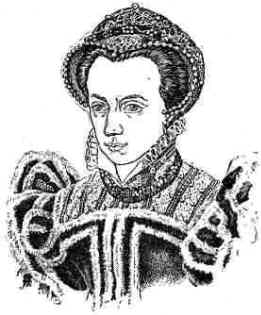
Mary Queen of Scots (1542-1587) was the daughter of James V of Scotland and Mary of Guise. She became Queen of Scotland when she was six days old after her father died at the Battle of Solway Moss.
A marriage was arranged between Mary and Edward, only son of Henry VIII but was broken when the Scots decided they preferred an alliance with France. Mary spent a happy childhood in France and in 1558 married Francis, heir to the French throne. They became king and queen of France in 1559.
Sadly, Francis died in 1560 and Mary, not wanting to stay in France, returned to Scotland. During Mary’s absence, Scotland had become a Protestant country. The Protestants did not want Mary, a Catholic and their official queen, to have any influence.
In 1565 Mary married her cousin and heir to the English throne, Henry Stuart, Lord Darnley. The marriage was not a happy one. Darnley was jealous of Mary’s close friendship with her secretary, David Rizzio and in March 1566 had him murdered in front of Mary who was six months pregnant with the future James I. Darnley made many enemies among the Scottish nobles and in 1567 his house was blown up. Darnley’s body was found inside, he had been strangled.
Three months later Mary married the chief suspect, the Earl of Bothwell. The people of Scotland were outraged and turned against her. She was removed from the throne and fled to England. She appealed to Elizabeth for help and support, but Elizabeth, suspicious that she was going to raise Catholic support and take the throne of England, kept Mary a virtual prisoner for the next eighteen years.
In 1586 letters sent to Mary by a Catholic called Thomas Babington, were found. The letters revealed a plot to kill Elizabeth and replace her with Mary. Elizabeth had no choice but to sign Mary’s death warrant. Mary Queen of Scots was beheaded at Fotheringay Castle on February 8th 1587.
The Tudors – Bloody Mary Counter Reformation
Mary I
Mary I, daughter of Henry VIII and Catherine of Aragon, has the misfortune of being remembered as ‘Bloody Mary’. The nickname implies that she was hated throughout the land for the burning of Protestants in her bid to restore Catholicism to England, but this was not the case. The nickname is the result of Protestant propaganda that portrays those burnt as heroes and Mary as an evil Queen.
Mary became Queen in 1553 following the death of her brother Edward and the deposement of Jane Grey. As a devout Catholic, Mary believed that unless Catholicism was restored in England, all her subjects would go to hell.
The Counter Reformation in England – Restoration of Catholicism
Mary’s prime goal from the time of her accession was to restore Catholicism. There were factors both in her favour and against:
In Mary’s Favour:
Protestantism had only been the official religion in England for six years, Catholicism had been the official religion for hundreds of years before.
The Protestants had not received the support of the people when they tried to replace Mary with Jane Grey.
Many Protestant leaders had fled to Europe when she became Queen.
Against Mary:
Henry VIII had closed the monasteries and sold the land to nobles and courtiers.
Mary was not married and at the age of 37 was almost beyond childbearing age. Next in line to the throne was her sister Elizabeth, a Protestant.
Although many Protestants had fled to Europe there were still many in England who would protest strongly against a return to Rome.
Marriage
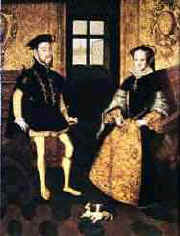
In 1554, Mary married Philip II of Spain. Spain was a Catholic country and Philip joined Mary in her bid to restore England to Rome. However, the marriage was not popular, the people had no wish to be governed by a foreigner and there was racial tension between the English and Spanish merchants in London. Thomas Wyatt led some 3,000 men from Rochester in Kent to London in protest against the Queen’s marriage and her anti-Protestant policies.
In 1555 Mary announced that she was pregnant and that the baby was due in June 1555. Many believed it to be a phantom pregnancy and they were proved right when no baby arrived. We now know that Mary probably had cancer of the womb.
Catholicism Enforced

The Catholic service, Holy Communion, and the elaborate fixtures and fittings of Catholic churches taken away during Edward’s reign were immediately restored. In 1555, Parliament passed a set of Heresy laws that made it a crime to be Protestant in England.
All Protestants who refused to convert to Catholicism were to be burnt. One of the first to go to the stake was John Rogers who had translated Tynedale’s Bible into English. The Bishops, Nicholas Ridley, Hugh Latimer and Thomas Cranmer followed soon afterwards. In all Mary was responsible for the burnings of 227 men and 56 women, mostly in the South East of England.
The Loss of Calais
In 1557 Philip persuaded Mary to commit England to helping him fight against France. Mary duly declared war on France. However, the move was disastrous for England and for Mary. The French invaded and reclaimed Calais, England’s last possession in France and the people were fed up with paying higher taxes to pay for a war that had only been started to help Spain.
The Tudors – Lady Jane Grey
Lady Jane Grey was born in October 1537. She was the daughter of Henry Grey and Frances Brandon, daughter of Henry VIII’s youngest sister, Mary. She was well educated and also a devout Protestant.
At the age of 9 years she was sent to court under the protection of Katherine Parr. After the death of Henry VIII she stayed with Katherine Parr. When Katherine Parr married Thomas Seymour, Jane joined their household.
Following Katherine Parr’s death in 1548, Jane became the ward of Thomas Seymour. Seymour tried, unsuccessfully, to arrange a marriage between Jane and Prince Edward. In 1549 Thomas Seymour was executed for treason and Jane became the ward of John Dudley.
In 1551 John Dudley was created Duke of Northumberland and Edward VI’s chief councillor.
By 1552 it was apparent that Edward VI would not survive to adulthood. John Dudley realised that if Mary or Elizabeth were to take the throne he would lose his high position. Since both Mary and Elizabeth had been declared illegitimate, Jane Grey had a claim to the throne. Dudley therefore decided to marry Jane to his son Guildford. The wedding took place on 25th May 1553.
Edward VI died on 6th July 1553. He had proclaimed Jane Grey as his successor on his deathbed over-ruling the terms of the Third Succession Act of 1543 which had restored Mary and Elizabeth to the line of succession.
Dudley attempted to withhold the news that Edward had died because he wanted to capture Mary and prevent her from gathering support and taking the throne from Jane. However, the plan failed and although Jane was officially proclaimed Queen on 10th July 1553, it was Mary that the people believed should be Queen.
Although Dudley attempted to raise a force against Mary, support for Mary was greater and on 19th July Mary was proclaimed Queen. Jane and her husband were imprisoned in the Tower of London. John Dudley, Duke of Northumberland was executed on 21st August 1553.
In January 1554 Thomas Wyatt led a rebellion against the marriage of Mary to Philip II of Spain. Many nobles joined the rebellion and called for Jane to be restored as Queen. Mary was pressured into authorising the execution of Jane Grey and Guildford Dudley to prevent further rebellions.
Jane Grey and her husband were executed on 12th February 1554.
The Tudors – Edward VI – Protestantism
Edward VI was just nine years old when his father died and he became King. His father had made provision for a Regency government comprised of 16 trusted men. However, Edward’s uncle, Edward Seymour, seized the regency for himself and the title ‘Protector of all the realms and dominions of the King’s majesty.’ Seymour placed Edward firmly under his control by removing him from his home and forbidding contact with his stepmother or sisters. He also gave himself the title Duke of Somerset.
Protestantism
Due to the break with Rome effected by Henry VIII, Edward had been educated by Protestant tutors, consequently he was a confirmed Protestant. Edward Seymour was also a Protestant and he encouraged Edward to make sweeping changes to the Church.
1547
The changes began immediately with the dissolving of the Chantries and the seizing of the money for the Crown. The dissolving of the Chantries was an attack on the Catholic belief in Purgatory and the saying of prayers for the dead.
1549
It was announced that priests would be allowed to marry. The Catholic religion demanded that priests remain celibate and forbade marriage.
1552
A new Prayer Book was introduced that included the following:
Altars were abolished and replaced by simple tables.
Priests were not to wear elaborate vestments.
The Mass was abolished and replaced with Holy Communion – the difference being that the bread and wine now only represented Christ and did not become Christ.
Predestination – the belief that it was already decided if you were bound for heaven or hell – was accepted. It was not possible to buy a place in heaven through good works, donating money to the church or saying prayers.
These changes meant that many Protestants from Europe came to England.
Death and Succession
Edward VI died in 1553 at the age of 15. By the terms of Henry VIII’s will, his eldest daughter, Mary, was next in line of succession. However, Edward’s Regent at the time, Sir John Dudley, Duke of Northumberland, wanted to prevent the accession of a Catholic monarch. It was therefore announced that as both Mary and Elizabeth were illegitimate they would not be able to take the throne. Chosen to be successor was Lady Jane Grey, grandaughter of Henry VIII’s youngest sister, Mary. In order to maintain his control, Northumberland married Jane to his son, Guildford. Jane became Queen of England, but only reigned for nine days. Mary raised her standard against Northumberland and, with the people on her side, claimed her rightful place on the throne on 19th July 1553. Northumberland, his son Guildford and Jane Grey were executed for treason.
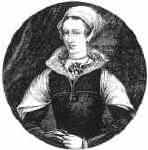
Lady Jane Grey
The Tudors – Catherine of Aragon Timeline
Date |
Summary |
Detailed Information |
| 16 Dec 1485 | Birth | Catherine of Aragon was born at Alcala de Henares in Spain. |
| 1489 | Treaty of Medina del Campo | The treaty of Medina Del Campo that agreed the marriage of prince Arthur of England to Catherine of Aragon was signed. |
| 18 July 1497 | Marriage Treaty | A new treaty agreed that Catherine would come to England when Arthur was fourteen and that her dowry of 200,000 crowns would be paid in installments. |
| Aug 1497 | Bethrothal | Prince Arthur and Catherine of Aragon were formally betrothed at the Palace of Woodstock. |
| Feb 1498 | Dispensation | Both Prince Arthur and Catherine of Aragon made formal appeals to the Pope to grant the necessary dispensation to allow them to marry before coming of age. |
| 1499 | Treaty of London | The Treaty of London made further arrangements for Catherine of Aragon’s marriage to Prince Arthur. |
| 19 May 1499 | Marriage by proxy | The marriage of Prince Arthur and Catherine of Aragon took place, by proxy, at Prince Arthur’s manor house at Bewdley. |
| 21 May 1501 | Catherine left her home | Catherine left the Alhambra in Granada for the port of Corunna where she would board a boat to England. |
| 20 July 1501 | Journey to England | Catherine reached the port of Corunna in the north west of Spain. |
| 17 Aug 1501 | Journey to England | After having to wait nearly a month for favourable winds, Catherine of Aragon set sail for England. |
| 21 Aug 1501 | Journey to England | A fierce storm in the Bay of Biscay forced Catherine of Aragon to return to Spain. Catherine was very frightened and thought she was going to die. The ships were so battered that they needed re-fitting before the journey could resume. |
| 27 Sept 1501 | Journey to England | Catherine of Aragon once again set sail for England. |
| 2 Oct 1501 | Journey to England | Catherine of Aragon finally arrived at Plymouth. The noblemen of Devon and Cornwall quickly formed an escort to take her to Exeter where she was to stay. |
| 16 Oct 1501 ? | Catherine welcomed | The King’s messengers arrived at Exeter. They brought a letter of welcome for Catherine and a delegation of the English court to escort her to London. |
| 4 Nov 1501 | Henry VII and Arthur leave London | Henry had planned to officially receive Catherine when she reached Lambeth, but, like his son, he was impatient to set eyes on the young bride and rode to intercept the party travelling towards London. |
| 9 Nov 1501 | Catherine reached London | Catherine arrived at Lambeth Palace where she rested. |
| 12 Nov 1501 | Formal entry to London | Catherine made her formal entry into London. The streets were hung with tapestries and she was greeted along the way by pageants. |
| 14 Nov 1501 | Wedding | Prince Arthur aged fifteen years and Catherine of Aragon, aged sixteen years, were married in St Paul’s Cathedral. Catherine was ‘given away’ by Prince Henry who escorted her up the aisle. The ceremony was conducted by the Archbishop of Canterbury, Henry Deane, who was assisted by the Bishop of London, William Warham. The couple knelt to take their vows on a platform, draped with red cloth, six feet high which ran the length of the nave to the west door of the choir. The wedding banquet was followed by dancing and the couple were publicly put to bed as was the custom. |
| mid-late Nov 1501 | Wedding Celebrations | The wedding celebrations lasted for two weeks and included daily jousts and banquets followed by pageants, disguising and dancing. |
| late Nov 1501 | Living Arrangements | The wedding celebrations were over and the court had moved to Windsor. Arthur had to return to the Welsh Marches to take up his position as Prince of Wales. Although some people thought that Catherine was too young to be expected to live in the Welsh Marches, it was eventually decided that they should live together as man and wife. |
| 28 Nov 1501 | Dowry Payment | The Spanish sovereigns handed over the first part of Catherine’s dowry, 100,000 crowns. |
| Dec 1501 | Nobles return to Spain | The Spanish nobles that had escorted Catherine to England returned to Spain with gifts from England. |
| 21 Dec 1501 | Journey to Wales | The Prince and Princess of Wales left Baynards Castle and travelled West to form their own court at Ludlow in the Welsh marches. |
| Jan 1502 | Ludlow Castle | The Prince and Princess of Wales arrived at Ludlow and set about making the castle, which had been uninhabited since 1483, warm and hospitable. |
| late March 1502 ? | Viral infection | Prince Arthur and his wife Catherine were struck down with a viral infection. |
| 2 April 1502 | Death of Arthur | Prince Arthur died at his castle in Ludlow, Shropshire. Arthur’s body lay in state at Ludlow Castle. |
| 23 April 1502 | Funeral and burial of Arthur | After a funeral service at the Parish church of Bewdley, Arthur was buried in the Abbey of St Wulfstan in Worcester. Catherine, as royal tradition dictated, did not attend her husband’s funeral. She was also still confined to her bed with the same virus that had killed Arthur. |
| late April 1502 | Return to London | As soon as she was well enough to travel Catherine, dressed in widow’s black travelled back to London. |
| 10 May 1502 | Negotiations for marriage to Henry | Ferdinand and Isabella were anxious not to lose the English alliance and instructed the Spanish ambassador to negotiate for a subsequent marriage to Prince Henry. |
| Autumn 1502 | Negotiations for marriage to Henry | Dr De Puebla was nominated to be the Spanish negotiator for the terms of Catherine’s subsequent marriage to Henry. He met daily with the English council. |
| 25 June 1503 | Betrothal to Henry | Prince Henry and Catherine of Aragon were formally betrothed by the Bishop of Salisbury. Catherine was now able to discard her mourning black and appeared dressed in white. |
| late June 1503 ? | Catherine at the mercy of Henry VII | The terms of the marriage treaty meant that Catherine had no income of her own and was completely at the mercy of the English King. |
| early Aug 1503 ? | Dispensation requested | A papal dispensation was requested from Pope Alexander VI by Ferdinand and Isabella of Spain and King Henry VII of England to allow Prince Henry to marry Catherine of Aragon. |
| 30 Sept 1503 | Marriage Treaty | The new treaty for the marriage of Prince Henry to Catherine of Aragon was ratified by Isabella of Spain. |
| Summer 1504 | Catherine ill | Catherine was taken ill with a mystery illness which kept her confined to bed for much of the summer. She was subject to fits of fever and shivering and at times it was feared that she would die. |
| July 1504 | Pope delays dispensation | The Pope wrote to Henry VII. He told him that he needed more time in which to examine the case of Prince Henry and Catherine of Aragon. |
| Aug 1504 | Spanish complain about dispensation delay | The Spanish ambassador, Estrada, formally complained about the delay in granting the dispensation. |
| Oct 1504 | Dispensation arrives | Julius II sent the dispensation that allowed Prince Henry to marry Catherine of Aragon, to England. |
| Jan 1505 | Catherine’s allowance stopped | Catherine’s dowry remained unpaid and Henry was not so keen on a Spanish alliance now that Spain was not united. Henry felt he could find a better match for his son and stopped Catherine’s allowance. |
| Feb 1505 | Catherine unable to pay her servants | Catherine now had no money of her own and was unable to pay her servants. the Spanish ambassador, Dr De Puebla, wrote to Ferdinand to seek his advice. |
| 27 June 1505 | Marriage to Henry delayed | Prince Henry, on his father’s orders, made secret but formal protest against marriage to his brother’s widow. the King was anxious to delay the marriage as he still hoped to find a better match for his son. However, he did not want to formally break off the engagement as he wanted to keep the first instalment of Catherine’s dowry which had been paid after her marriage to Arthur. |
| Nov 1505 ? | Catherine told to join the King’s court | Catherine, as mistress of her own court at Durham House, was faced with severe financial problems. After protesting to Henry VII, she was instructed to give up Durham House and join the court. |
| 24 Nov 1505 | Spain tries to speed up marriage | Ferdinand sent copies of the papal dispensation, sent to Spain, to England hoping to speed up the marriage of his daughter. |
| Dec 1505 | Catherine in poor financial situation | Catherine’s financial position was very bad. With both her father and the King refusing to give her an allowance she was finding it difficult to pay her household. |
| Feb 1506 | Visit by Philip and Juanna | Catherine was provided with new clothes to wear during the festivities laid on for the visit by her sister Juanna and her husband Philip. Although Catherine wanted to tell her sister about her situation in England she was given no opportunity to speak to her sister alone. |
| late April 1506 | Marriage to Henry postponed | Henry VII stated publicly that because prince Henry had been underage at the time of his betrothal, the ceremony, which had been held in 1503, was therefore invalid. All further discussions regarding a marriage between prince Henry and Catherine of Aragon were to be postponed until the remainder of her dowry was paid. |
| Summer 1506 | Catherine’s situation in England bad | Catherine now had no money to pay her servants. She suffered recurrent bouts of fever and her illness was made worse by the high state of anxiety regarding her position in England. |
| Autumn 1506 | Catherine and Prince Henry | Catherine of Aragon’s health improved and she began to spend time in the company of Prince Henry. they began to enjoy each other’s company. |
| late Autumn 1506 ? | Catherine sent away from court | Henry VII was alarmed when he discovered how close Prince Henry had become to Catherine. He sent Catherine and her household to live at Fulham Palace, saying that the country air would be more beneficial for her health. ? |
| March 1507 | Catherine’s dowry demanded | Henry VII gave Ferdinand a six-month deadline in which to hand over the second part of Catherine’s dowry. |
| July or Sept 1507 | Catherine receives money from Spain | Ferdinand sent Catherine two thousand ducats but the money was not nearly enough. Over the years, Catherine had been forced to pawn many pieces of jewel and plate which was part of her dowry. |
| Oct 1507 | Catherine’s dowry | Henry VII extended the deadline for the payment of Catherine’s dowry to March 1508. He did not want to lose the money. |
| Sept 1508 | Catherine’s situation in England worsens | Henry was angry that Ferdinand had not paid his daughter’s dowry as arranged and broke off Catherine’s allowance. Fuensalida wrote to Ferdinand asking him to send a ship to the Thames so that he and Catherine could return to Spain. |
| Early 1509 | Catherine’s situation | Catherine’s financial situation was now worse than ever, not only did she have no money with which to pay her servants, she now had nothing left to pawn. |
| 21 April 1509 | Death of Henry VII | After a long illness, King Henry VII, aged fifty-two years, died from tuberculosis at Richmond palace, Surrey. He was buried in Westminster Abbey. |
| Early June 1509 | Henry proposed to Catherine | The members of the Privy Council urged Henry to marry Catherine of Aragon. Henry visited Catherine in her private apartments and, after dismissing her servants, asked her to be his wife. Catherine had, by now, learned enough English to get by and was able to accept his proposal. |
| 11 June 1509 | Wedding | King Henry VIII and Catherine of Aragon were privately married by the Archbishop of Canterbury, William Warham, in the Church of the palace Friary at Greenwich. It was necessary for the marriage to be kept a very quiet affair because Henry was still in mourning for his father. |
| 15 June 1509 | Queen of England | Catherine made her first appearance at court as Queen of England. |
| Aug 1509 | Pregnancy | Catherine announced that she was pregnant. |
| 31 Jan 1510 | Stillbirth daughter | Catherine was prematurely delivered of a stillborn daughter. Both the King and Queen were disappointed, but not unduly so, for miscarriage or stillbirth of a first pregnancy was a common occurrence. |
| May 1510 | Second Pregnancy | Catherine of Aragon announced her second pregnancy. |
| 1 Jan 1511 | Birth of Prince Henry | Queen Catherine was delivered of a son who was named Henry after his father. Guns were fired from the Tower and the city bells were rung. Beacons were lit and free wine was distributed to all Londoners. The new prince was immediately created Prince of Wales. |
| 6 Jan 1511 | Prince Henry Christened | Prince Henry was christened at Richmond. His godparents were, the Archbishop of Canterbury, the earl of Surrey and the Countess of Devon. |
| 22 Feb 1511 | Death of Prince Henry | Prince Henry died at Richmond Palace. Both King and Queen were devastated. The young prince was given a lavish funeral and was buried in Westminster Abbey. |
| 30 June 1513 | Catherine Regent of England | Catherine was left as regent in England when Henry went to fight in France. |
| 9 Sept 1513 | Battle of Flodden Field | The English defeated the Scots at the Battle of Flodden Field. Catherine ordered that the bloodied coat of James IV be sent to Henry in France. |
| Nov 1513 | Birth and death of premature son | Queen Catherine went into labour prematurely. She was delivered of a son at Richmond Palace, Surrey, who was styled Duke of Cornwall from birth. He died shortly after birth and was buried in Westminster Abbey. |
| June 1514 | Fourth pregnancy | Catherine announced that she was pregnant again. |
| 8 Jan 1515 | Stillborn son | Catherine of Aragon was delivered of a stillborn son. |
| Summer 1515 | Fifth pregnancy | Queen Catherine announced her fifth pregnancy. However, less hope was placed on an heir resulting from the pregnancy. |
| 18 Feb 1516 | Birth of Mary I | Queen Catherine was delivered of a healthy baby girl at 4am at Greenwich Palace, Kent. She was named Mary. Although celebrations to mark the birth were genuine, there was still disappointment that she had not been a boy. Henry tried to hide his disappointment by saying that if it were a girl this time then surely boys would follow. |
| 20/21 Feb 1516 ? | Mary’s Christening | The princess Mary was christened in the chapel of Observant friars at Greenwich. |
| Feb 1518 | Sixth Pregnancy | At the age of thirty-two years, the Queen conceived for the sixth time. |
| March 1518 | Pilgrimage | Queen Catherine visited Merton College, Oxford. The visit was combined with a pilgrimage to the shrine of St Frideswide. |
| 10 Nov 1518 | Birth and death of daughter | The Queen was delivered of a daughter, but she was weak and died within days. |
| Summer 1519 | Birth of Henry Fitzroy | Catherine learned that Henry’s mistress, Bessie Blount had given birth to a son, Henry Fitzroy. She was upset and humiliated and began to withdraw from court life. |
| 11-22/24 June 1520 ? | Field of the Cloth of Gold | Catherine accompanied Henry to France for a meeting with Francis I at the field of the cloth of gold. |
| 1524 | Henry begins to doubt marriage | Henry stopped having sexual relations with Catherine who was plagued with gynaecological problems. He no longer found his wife desirable and was beginning to have serious doubts regarding the validity of his marriage. He believed that God was punishing him for marrying his brother’s wife by not giving him a son. |
| Aug 1525 | Princess Mary sent to Ludlow | Princess Mary was sent to Ludlow to establish her own court. Catherine was upset that she was to be parted from her daughter indefinitely. |
| 1526 | Institution of a Christian Marriage | Catherine of Aragon gave her approval to Erasmus’ book ‘The Institution of a Christian Marriage’, she had been shown the book by Thomas More. |
| Christmas 1526 ? | Princess Mary returns to Court | Catherine was reunited with her daughter when Mary came to court for Christmas which was held at Greenwich. |
| Spring 1527 | Henry wants a divorce | Henry was concerned about the validity of his marriage. He reasoned that his lack of male issue was God’s punishment for having married his brother?s wife. This reasoning together with his infatuation with Anne Boleyn, led him to the decision that he must divorce Catherine. |
| 22 June 1527 | Henry tells Catherine of separation | Henry told Catherine that they must separate because they had been living in sin. He asked her to co-operate and to choose a house to retire to until the matter was resolved. Catherine was stunned and upset and made it quite plain that she would resist any divorce. |
| Oct 1527 | Charles of Spain pressured the Pope | Charles told the pope that he was going to protect his aunt, Catherine of Aragon. He demanded that Clement take no steps that would further an annulment. |
| Summer 1528 | Public support for Catherine | The population of England were still firmly on the Queen’s side with regard to the King’s divorce and cried “victory over your enemies” whenever she was seen. |
| Autumn 1528 | Catherine isolated | Catherine still lived at court but was now left in relative isolation with the majority of courtiers seeking out Anne Boleyn in preference to Catherine. |
| early Oct 1528 ? | Catherine’s counsel for the divorce | Catherine’s counsel for the divorce case included, William Warham, Archbishop of Canterbury, John Fisher, Bishop of Rochester, Dr Henry Standish, Bishop of St Asaph’s, Cuthbert Tunstall, Bishop of London and John Clerk, Bishop of Bath and Wells. |
| Oct 1528 | Divorce case | Catherine announced that she had in her possession a copy of the dispensation issued by Julius II in 1504 allowing her to marry Henry regardless of whether her marriage to Arthur was consummated or not. |
| 24 Oct 1528 | Catherine refused to enter a convent | Campeggio met Catherine. He advised her to enter a convent and retire gracefully. She made it plain that she intended to live and die a married woman. |
| late Oct 1528 | Public Support for Catherine | Catherine was as popular as ever with the people who cheered her in large numbers whenever she was out. Anne Boleyn on the other hand, was insulted with cries of “adulteress and sorceress”. Catherine received a letter telling her that by riding out and attracting the cheers of the people, she was inciting rebellion. The council also told her that if she continued to work against the King in this way she would be completely separated from both the City and Princess Mary. |
| Nov 1528 ? | Catherine separated from Mary | Because she continued to fight the divorce, Catherine was now separated from Mary and the isolation she was kept in meant that she was very lonely, but she still refused to enter a convent. |
| Jan 1529 | Catherine appealed to Rome | Catherine lodged an appeal to Rome against the authority of the Legatine Court and the ability of Wolsey and Campeggio to try the case. |
| April 1529 | Catherine’s representatives | Henry asked Catherine to choose those she wished to represent her during the forthcoming trial. Although she still refused to acknowledge the authority of the Legatine Court, she chose Archbishop Warham, Cuthbert Tunstall, Bishop of Ely and St Asaph and her main supporter, John Fisher, Bishop of Rochester. |
| 31 May 1529 ? | Divorce case began | Wolsey and Campeggio opened court at Blackfriars. Henry and Catherine were summoned to appear before the court on 18th June. |
| 6 June 1529 | Formal protest to Rome | Catherine made formal protest to Rome against the Legatine Court. |
| 18 June 1529 | Catherine questions valildity of Divorce Court | Catherine was loudly applauded as she made her way to the Legatine Court. Once inside, she challenged that authority of the Court and the qualification of the two legates to hear the cast. She stated her wish for the case to be heard in Rome, but this was denied. Both Catherine and Henry were told to reappear on 21st June. |
| mid July 1529 | Pressure put on Catherine | Henry ordered the legates to visit Catherine and persuade her to submit to his wishes. Catherine was reluctant to receive them privately saying that they could speak freely in front of her women. She maintained her belief in the legitimacy of her marriage. |
| 23 July 1529 | Divorce case adjourned | The Legatine court reassembled at Blackfriars. The house was packed as it had been rumoured that a decision would be made. However, Campeggio announced that because of the large number of documents to be examined he would be unable to give judgement today. He went on to say that the court would now have to be adjourned until October because it was practice in Rome to break for the summer months. |
| Aug 1529 | Henry summoned to Rome | Henry received a summons from Rome to appear before the papal curia. He was furious. His anger with Rome was growing as was the awareness that the Pope may never grant him a divorce. He realised that he needed to find another solution. |
| Autumn 1529 | Cranmer suggests divorce tried by universities | Thomas Cranmer was summoned to appear before the King. Cranmer told Henry that it was his opinion that the marriage should be tried by the Doctors of Divinity in the Universities for it was them that studied the Bible and were therefore better qualified to discuss its meaning. If the marriage were found to be invalid then all that would be necessary would be for the Archbishop of Canterbury to pronounce the King a free man. |
| 30 Nov 1529 | Henry dined with Catherine | Henry was fed up with Anne’s complaints and chose, instead, to dine with Catherine. However, the evening did not go as he had expected. Catherine was angry that he treated her so badly in private while in public he was civil and courteous. |
| early Dec 1529 | Catherine ordered to go to Richmond | Catherine was ordered to leave Greenwich Palace and go to Richmond. |
| 24 Dec 1529 | Henry determined to divorce Catherine | Henry told Catherine that even if the Pope declared their marriage to be lawful he would still have his divorce. He told her that the Church of Canterbury was more important than that of Rome and that if the Pope found against him then he would declare the Pope a heretic and marry wherever he chose. Catherine had been brought back to court for Christmas because there was a general sense of unease since she had been sent from court. |
| Late Dec 1529 | Catherine returns to Richmond | With the Christmas festivities over, Catherine was sent back to Richmond. |
| March 1530 | No action from the Pope | At Catherine’s request, the Pope issued a brief that forbade Henry from re-marrying until a verdict had been passed on his marriage in Rome. However, the Pope refused to publish it. |
| April 1530 | Catherine appeals to Rome | Catherine wrote to her representative in Rome, Dr Pedro Ortiz. She begged him to put pressure on the Pope to find her marriage lawful. |
| June 1530 | Divorce Campaign | A massive campaign was launched to declare that the relevant passage in Leviticus was subject to Canon law and libraries across Europe were searched for information that would help prove the King’s case. All those scholars deciding that Henry had a good case were sent a sum of money. |
| June/July 1530 | Catherine Optimistic | Catherine was feeling more optimistic. She was heartened by her nephew’s stand for Catholicism in Germany and by the news that Anne Boleyn was losing popularity with the Court. |
| Nov 1530 | Catherine ill | Catherine, who was ill, was left alone at Richmond while Henry went to London with Anne Boleyn. |
| Christmas 1530 | Catherine at Court for Christmas | Catherine, whose health had improved, was present at court for the Twelfth Night celebrations, that included a masque and dancing. Henry was courteous towards her and dined at the same table. |
| March 1531 | Henry visited Catherine | In an attempt to make people believe that he was forced to set aside his wife against his will, Henry visited Catherine regularly. |
| 31 May 1531 | Pressure put on Catherine | A deputation of Privy Councillors – Dr Stephen Gardiner, Rowland Lee, Dr Sampson and Longland, Bishop of Lincoln – were sent to try to persuade Catherine to agree to an annulment of her marriage. She refused and went on to deny Henry’s Supremacy of the Church and stated that she would only abide by a decision made by the Pope. |
| June 1531 | Catherine to be with Mary | In an attempt to appease Catherine, Henry arranged for her to be with Mary when the court moved to Windsor. |
| 11/14 July 1531 ? | Henry left Catherine at Windsor | Henry moved the court to Woodstock for a spell of hunting. He did not tell Catherine about the move, choosing, instead, to leave her and Mary alone in the deserted apartments at Windsor. On finding her husband gone, Catherine wrote to Henry expressing her regret that she hadn’t been up to say goodbye to him when he left to go hunting. |
| Christmas 1531 | Catherine ignored | Catherine was not invited to court for Christmas and Henry returned her gift saying that they were no longer man and wife it was not proper for them to exchange gifts. |
| Jan 1532 | Mary allowed to visit Catherine | Princess Mary made a much publicised visit to her mother at Enfield. Henry had reluctantly agreed to the visit in a bid to placate his subjects. However, he was very worried that mother and daughter might intrigue against him with the Emperor and he vowed to keep them apart in future. |
| May 1532 | Catherine told to move | Catherine was instructed to leave The More and move to the palace at Bishop’s Hatfield in Hertfordshire. |
| August 1532 | Catherine further isolated | Catherine’s closest friend, Maria de Salinas, Lady Willoughby, was ordered to leave Catherine’s household. she was told not to make any attempt to communicate with Catherine. |
| August 1532 | Supporter sent to the Tower | Thomas Abell, who had spoken in public for Catherine, was sent to the Tower. |
| early Sept 1532 ? | Cranmer Archbishop of Canterbury | Thomas Cranmer who supported royal supremacy over the church, was appointed Archbishop of Canterbury. However, he was in Germany serving as English ambassador to the German court. |
| 13 Sept 1532 | Catherine told to move | Catherine was told to move to Enfield where she would be less comfortable. |
| 1533 | Catherine’s former confessor imprisoned | John Forrest, a member of the Observant Friars at Greenwich, former confessor of Catherine, was imprisoned for supporting Catherine rather than the King. |
| early Jan 1533 | Anne Boleyn pregnant | Anne Boleyn told Henry that she was pregnant. Henry now knew he had to marry Anne as soon as possible to ensure the child’s legitimacy. He decided that the marriage should take place as soon as possible, but should be kept secret until an ace could be passed abolishing all appeals to Rome. |
| Feb 1533 | Catherine ordered to move again | Henry ordered Catherine to move to Ampthill which was some distance from London. She wrote letters to both the Pope and Charles saying that she wanted no bloodshed and would not sanction any invasion of England on her behalf. |
| 1 April 1533 | Decision on marriage made | Convocation declared by 14 votes to 7 that if Catherine’s first marriage had been consummated, then her marriage to Henry was against God’s law and as such invalid. |
| 5 April 1533 | Decision on Pope’s authority | Convocation ruled that the Pope did not have the authority to issue a bull setting aside the ruling in Leviticus that no man shall marry his brother’s wife. The ruling was opposed by Fisher. |
| 7 April 1533 | Act in Restraint of Appeals | Act in Restraint of Appeals The passing of this act forbade all appeals to foreign tribunals in all spiritual, revenue and testamentary cases. Spiritual and secular jurisdiction was to be the ultimate responsibility of the King and the Pope’s right of intervention was abolished. This bill had taken several weeks to pass through parliament, with some, such as Sir George Throckmorton, speaking against it. It had to be amended before it would be accepted. It was obvious to all that this act had been passed to prevent Catherine making any further appeal to Rome. |
| 9 April 1533 | Catherine told of King’s marriage | Norfolk and Suffolk were sent to Ampthill to tell Catherine that Henry and Anne were married. She was told that as she was now no longer queen she must use the title Princess dowager of Wales. She was allowed to keep her property but her servants and household expenses would now be her responsibility. She was also told that if she submitted to the King’s will she would be generously provided for. |
| 8 May 1533 | Court to try validity of marriage opened | Thomas Cranmer opened court and duly summoned Catherine to appear. However, he was very worried of the consequences should she decide to appear in person. |
| 13 May 1533 | Marriage declared invalid | Thomas Cranmer pronounced judgement on Henry’s marriage. He declared the marriage null and void on the grounds that it was contrary to divine law. Bishop Fisher was the only bishop to protest against the decision and secretly appealed to Charles to intervene, using force if necessary. However, although angry, Charles had no intention of starting a war. |
| 3 July 1533 | Catherine told to agree to the King’s wishes | Catherine was visited by a deputation of Councillors led by Lord Mountjoy. She was told that if she would submit to the King’s wishes he would provide her with a handsome estate but that if she persisted in her obstinacy things would go badly for her daughter and servants. |
| Late July 1533 ? | Catherine ordered to move again | Henry was furious with Catherine’s continual obstinacy and ordered her to move to the Bishop of Lincoln’s Palace at Buckden in Huntingdonshire. |
| early Dec 1533 | Catherine requested a more favourable move | Catherine swallowed her pride and wrote to Henry asking if she might be allowed to move to a healthier house. Henry replied that she could move to Fotheringay Castle if she chose. Knowing it to be worse than Buckden, Catherine declined. |
| early 1534 | Act in Absolute Restraint of Appeals | The Act in Absolute Restraint of Appeals This act put into effect the terms of the Act of 1532 and transferred all payments from the pope to the King. Henry was declared to be, next to Christ, the only Supreme Head on Earth of the Church of England. It also laid down that all future abbots and bishops were to be chosen for election by the King. |
| 23 March 1534 | Act of Succession | Act of Succession. This Act was introduced to exclude Mary from the succession and settle it instead on the children born from his marriage to Anne. It registered the invalidity of Henry’s first marriage and proclaimed his second to be legal. Severe penalties were to be imposed on all those who opposed Henry’s second marriage and this Act, either openly or secretly. The Act also gave Henry the power to extract oaths from any of his subjects regarding the provisions of the Act. Anyone refusing to swear the oath would be guilty of treason. |
| early April 1534 ? | Catherine refused Oath of Succession | Catherine refused to swear the oath of succession. She now feared for both her own and her daughter’s life. She only ate food prepared by trusted servants and kept a constant watch on all strangers. |
| mid May 1534 | Catherine moved to Kimbolten | Catherine moved to Kimbolten Castle. Henry’s loyal subjects, Sir Edmund Bedingfield and Sir Edward Chamberlain, were appointed Steward and Chamberlain respectively. They were told that Catherine was to receive no visitors unless they held a special licence from the King. Catherine spent most of her time in the seclusion of her own rooms with a few trusted servants. Her apartments were more comfortable than those of Buckden and from her window she could look across the rooftops to the country beyond. She also had her own chapel behind which was a small walled garden where she could walk on fine days. |
| June 1534 ? | Catherine refused Oath of Succession again | The Bishop of Durham was sent to make Catherine swear to the Oath of Succession. However, she steadfastly refused to take the oath. |
| July 1534 | Catherine ill | Catherine’s health began to deteriorate. Chapuys begged Henry to allow him to visit her but permission was refused. Chapuys left London with a large escort to visit Catherine at Kimbolten Castle. He made a great show of the journey, however, five miles from the castle he was met by one of Catherine’s messengers who said that she had been forbidden to meet him. He turned back satisfied that the people knew Spain supported Catherine. |
| mid Sept 1534 | Catherine’s health worsened | Catherine’s health continued to deteriorate. Her friend Maria de Salinas, Lady Willoughby, begged permission to visit her but permission was denied. |
| Nov 1534 | Act of Supremacy | This Act made Henry the Head of the Church of England. He now had more power than ever and was determined that he would not be opposed. |
| April 1535 | Escape Plan | With Charles’ backing, Chapuys tried to find a way for Catherine and Mary to escape England. He planned to smuggle them out at night and go down river to Gravesend where a Spanish boat would take them to the Netherlands. |
| 10 May 1535 | Escape Plan cancelled | Charles wrote to Chapuys saying that it was too risky to try to effect Catherine and Mary’s escape. Chapuys was forced to abandon all plans for escape as it was feared that Mary and Catherine would be executed if they were discovered. |
| 1 Dec 1535 | Catherine ill again | Catherine was taken seriously ill. She was complaining of chest pains, was unable to eat and was confined to bed. |
| 14 Dec 1535 | Catherine slightly better | Catherine had recovered slightly and was able to sit in a chair. She wrote to Charles asking for money to pay her servants as her funds were depleted. |
| 17 Dec 1535 | Fiftieth birthday | Catherine celebrated her fiftieth birthday. |
| 26 Dec 1535 | Catherine very ill | Catherine was again taken ill and was forced to take to her bed again. |
| 30 Dec 1535 ? | Catherine dying | Henry gave Chapuys permission to visit Catherine who was now considered to be dying. Mary was still refused permission to see her mother although Henry did agree to reconsider this. |
| 2 Jan 1536 | Catherine on deathbed | Chapuys, the Spanish ambassador, arrived at Kimbolten Castle to see Catherine. He knelt at her bedside and kissed her hand. Catherine told him that she could die happy now she knew she was not abandoned. She asked him questions about Henry and Mary. |
| 4 Jan 1536 ? | Deathbed confession | Chapuys told Catherine’s physician that if her condition deteriorated she was to swear on her deathbed that her marriage to Arthur had not been consummated. Much store was set by deathbed confessions. |
| 5 Jan 1536 | Catherine visited by Lady Willoughby | Maria de Salinas, Lady Willoughby, forced her way into Kimbolten Castle to see Catherine, having been refused permission to visit. |
| 6 Jan 1536 | Catherine made her will | Catherine seemed a little better today and even tidied her hair before spending a long while talking to Maria de Salinas. Catherine also made her will, despite it being against the law for a woman to make a will while her husband lived. She asked for her debts to be paid and her servants rewarded for the good service they had given. She bequeathed a collar of gold that she had brought from Spain to Mary as well as her furs. Chapuys left Kimbolten as Catherine seemed so much stronger. |
| 7 Jan 1536 | Catherine died | Catherine awoke with stomach pains and nausea. She quickly became very weak and her confessor was summoned. She dictated two letters, one to Henry and one to Charles. She received Holy Communion and extreme unction then prayed aloud for two hours. Catherine of Aragon died at 2 p.m. at Kimbolton Castle, Huntingdonshire, probably of cancer. |
| 8 Jan 1536 | Cause of death | An autopsy was carried out on Catherine’s body. A black growth was found on her heart but no other abnormalities. They pronounced the growth to be caused by poisoning. It was widely believed that Anne Boleyn had slowly poisoned Catherine to death and the death of Mary was expected to follow. The news that Catherine had been poisoned spread throughout Europe. |
| Funeral | Catherine was given a state funeral as widow of the Prince of Wales. Henry and Anne Boleyn did not attend the funeral. Catherine was buried in Peterborough Abbey. | |
| Date | Summary | Detailed Information |
| 16 Dec 1485 | Birth | Catherine of Aragon was born at Alcala de Henares in Spain. |
| 1489 | Treaty of Medina del Campo | The treaty of Medina Del Campo that agreed the marriage of prince Arthur of England to Catherine of Aragon was signed. |
| 18 July 1497 | Marriage Treaty | A new treaty agreed that Catherine would come to England when Arthur was fourteen and that her dowry of 200,000 crowns would be paid in installments. |
| Aug 1497 | Bethrothal | Prince Arthur and Catherine of Aragon were formally betrothed at the Palace of Woodstock. |
| Feb 1498 | Dispensation | Both Prince Arthur and Catherine of Aragon made formal appeals to the Pope to grant the necessary dispensation to allow them to marry before coming of age. |
| 1499 | Treaty of London | The Treaty of London made further arrangements for Catherine of Aragon’s marriage to Prince Arthur. |
| 19 May 1499 | Marriage by proxy | The marriage of Prince Arthur and Catherine of Aragon took place, by proxy, at Prince Arthur’s manor house at Bewdley. |
| 21 May 1501 | Catherine left her home | Catherine left the Alhambra in Granada for the port of Corunna where she would board a boat to England. |
| 20 July 1501 | Journey to England | Catherine reached the port of Corunna in the north west of Spain. |
| 17 Aug 1501 | Journey to England | After having to wait nearly a month for favourable winds, Catherine of Aragon set sail for England. |
| 21 Aug 1501 | Journey to England | A fierce storm in the Bay of Biscay forced Catherine of Aragon to return to Spain. Catherine was very frightened and thought she was going to die. The ships were so battered that they needed re-fitting before the journey could resume. |
| 27 Sept 1501 | Journey to England | Catherine of Aragon once again set sail for England. |
| 2 Oct 1501 | Journey to England | Catherine of Aragon finally arrived at Plymouth. The noblemen of Devon and Cornwall quickly formed an escort to take her to Exeter where she was to stay. |
| 16 Oct 1501 ? | Catherine welcomed | The King’s messengers arrived at Exeter. They brought a letter of welcome for Catherine and a delegation of the English court to escort her to London. |
| 4 Nov 1501 | Henry VII and Arthur leave London | Henry had planned to officially receive Catherine when she reached Lambeth, but, like his son, he was impatient to set eyes on the young bride and rode to intercept the party travelling towards London. |
| 9 Nov 1501 | Catherine reached London | Catherine arrived at Lambeth Palace where she rested. |
| 12 Nov 1501 | Formal entry to London | Catherine made her formal entry into London. The streets were hung with tapestries and she was greeted along the way by pageants. |
| 14 Nov 1501 | Wedding | Prince Arthur aged fifteen years and Catherine of Aragon, aged sixteen years, were married in St Paul’s Cathedral. Catherine was ‘given away’ by Prince Henry who escorted her up the aisle. The ceremony was conducted by the Archbishop of Canterbury, Henry Deane, who was assisted by the Bishop of London, William Warham. The couple knelt to take their vows on a platform, draped with red cloth, six feet high which ran the length of the nave to the west door of the choir. The wedding banquet was followed by dancing and the couple were publicly put to bed as was the custom. |
| mid-late Nov 1501 | Wedding Celebrations | The wedding celebrations lasted for two weeks and included daily jousts and banquets followed by pageants, disguising and dancing. |
| late Nov 1501 | Living Arrangements | The wedding celebrations were over and the court had moved to Windsor. Arthur had to return to the Welsh Marches to take up his position as Prince of Wales. Although some people thought that Catherine was too young to be expected to live in the Welsh Marches, it was eventually decided that they should live together as man and wife. |
| 28 Nov 1501 | Dowry Payment | The Spanish sovereigns handed over the first part of Catherine’s dowry, 100,000 crowns. |
| Dec 1501 | Nobles return to Spain | The Spanish nobles that had escorted Catherine to England returned to Spain with gifts from England. |
| 21 Dec 1501 | Journey to Wales | The Prince and Princess of Wales left Baynards Castle and travelled West to form their own court at Ludlow in the Welsh marches. |
| Jan 1502 | Ludlow Castle | The Prince and Princess of Wales arrived at Ludlow and set about making the castle, which had been uninhabited since 1483, warm and hospitable. |
| late March 1502 ? | Viral infection | Prince Arthur and his wife Catherine were struck down with a viral infection. |
| 2 April 1502 | Death of Arthur | Prince Arthur died at his castle in Ludlow, Shropshire. Arthur’s body lay in state at Ludlow Castle. |
| 23 April 1502 | Funeral and burial of Arthur | After a funeral service at the Parish church of Bewdley, Arthur was buried in the Abbey of St Wulfstan in Worcester. Catherine, as royal tradition dictated, did not attend her husband’s funeral. She was also still confined to her bed with the same virus that had killed Arthur. |
| late April 1502 | Return to London | As soon as she was well enough to travel Catherine, dressed in widow’s black travelled back to London. |
| 10 May 1502 | Negotiations for marriage to Henry | Ferdinand and Isabella were anxious not to lose the English alliance and instructed the Spanish ambassador to negotiate for a subsequent marriage to Prince Henry. |
| Autumn 1502 | Negotiations for marriage to Henry | Dr De Puebla was nominated to be the Spanish negotiator for the terms of Catherine’s subsequent marriage to Henry. He met daily with the English council. |
| 25 June 1503 | Betrothal to Henry | Prince Henry and Catherine of Aragon were formally betrothed by the Bishop of Salisbury. Catherine was now able to discard her mourning black and appeared dressed in white. |
| late June 1503 ? | Catherine at the mercy of Henry VII | The terms of the marriage treaty meant that Catherine had no income of her own and was completely at the mercy of the English King. |
| early Aug 1503 ? | Dispensation requested | A papal dispensation was requested from Pope Alexander VI by Ferdinand and Isabella of Spain and King Henry VII of England to allow Prince Henry to marry Catherine of Aragon. |
| 30 Sept 1503 | Marriage Treaty | The new treaty for the marriage of Prince Henry to Catherine of Aragon was ratified by Isabella of Spain. |
| Summer 1504 | Catherine ill | Catherine was taken ill with a mystery illness which kept her confined to bed for much of the summer. She was subject to fits of fever and shivering and at times it was feared that she would die. |
| July 1504 | Pope delays dispensation | The Pope wrote to Henry VII. He told him that he needed more time in which to examine the case of Prince Henry and Catherine of Aragon. |
| Aug 1504 | Spanish complain about dispensation delay | The Spanish ambassador, Estrada, formally complained about the delay in granting the dispensation. |
| Oct 1504 | Dispensation arrives | Julius II sent the dispensation that allowed Prince Henry to marry Catherine of Aragon, to England. |
| Jan 1505 | Catherine’s allowance stopped | Catherine’s dowry remained unpaid and Henry was not so keen on a Spanish alliance now that Spain was not united. Henry felt he could find a better match for his son and stopped Catherine’s allowance. |
| Feb 1505 | Catherine unable to pay her servants | Catherine now had no money of her own and was unable to pay her servants. the Spanish ambassador, Dr De Puebla, wrote to Ferdinand to seek his advice. |
| 27 June 1505 | Marriage to Henry delayed | Prince Henry, on his father’s orders, made secret but formal protest against marriage to his brother’s widow. the King was anxious to delay the marriage as he still hoped to find a better match for his son. However, he did not want to formally break off the engagement as he wanted to keep the first instalment of Catherine’s dowry which had been paid after her marriage to Arthur. |
| Nov 1505 ? | Catherine told to join the King’s court | Catherine, as mistress of her own court at Durham House, was faced with severe financial problems. After protesting to Henry VII, she was instructed to give up Durham House and join the court. |
| 24 Nov 1505 | Spain tries to speed up marriage | Ferdinand sent copies of the papal dispensation, sent to Spain, to England hoping to speed up the marriage of his daughter. |
| Dec 1505 | Catherine in poor financial situation | Catherine’s financial position was very bad. With both her father and the King refusing to give her an allowance she was finding it difficult to pay her household. |
| Feb 1506 | Visit by Philip and Juanna | Catherine was provided with new clothes to wear during the festivities laid on for the visit by her sister Juanna and her husband Philip. Although Catherine wanted to tell her sister about her situation in England she was given no opportunity to speak to her sister alone. |
| late April 1506 | Marriage to Henry postponed | Henry VII stated publicly that because prince Henry had been underage at the time of his betrothal, the ceremony, which had been held in 1503, was therefore invalid. All further discussions regarding a marriage between prince Henry and Catherine of Aragon were to be postponed until the remainder of her dowry was paid. |
| Summer 1506 | Catherine’s situation in England bad | Catherine now had no money to pay her servants. She suffered recurrent bouts of fever and her illness was made worse by the high state of anxiety regarding her position in England. |
| Autumn 1506 | Catherine and Prince Henry | Catherine of Aragon’s health improved and she began to spend time in the company of Prince Henry. they began to enjoy each other’s company. |
| late Autumn 1506 ? | Catherine sent away from court | Henry VII was alarmed when he discovered how close Prince Henry had become to Catherine. He sent Catherine and her household to live at Fulham Palace, saying that the country air would be more beneficial for her health. ? |
| March 1507 | Catherine’s dowry demanded | Henry VII gave Ferdinand a six-month deadline in which to hand over the second part of Catherine’s dowry. |
| July or Sept 1507 | Catherine receives money from Spain | Ferdinand sent Catherine two thousand ducats but the money was not nearly enough. Over the years, Catherine had been forced to pawn many pieces of jewel and plate which was part of her dowry. |
| Oct 1507 | Catherine’s dowry | Henry VII extended the deadline for the payment of Catherine’s dowry to March 1508. He did not want to lose the money. |
| Sept 1508 | Catherine’s situation in England worsens | Henry was angry that Ferdinand had not paid his daughter’s dowry as arranged and broke off Catherine’s allowance. Fuensalida wrote to Ferdinand asking him to send a ship to the Thames so that he and Catherine could return to Spain. |
| Early 1509 | Catherine’s situation | Catherine’s financial situation was now worse than ever, not only did she have no money with which to pay her servants, she now had nothing left to pawn. |
| 21 April 1509 | Death of Henry VII | After a long illness, King Henry VII, aged fifty-two years, died from tuberculosis at Richmond palace, Surrey. He was buried in Westminster Abbey. |
| Early June 1509 | Henry proposed to Catherine | The members of the Privy Council urged Henry to marry Catherine of Aragon. Henry visited Catherine in her private apartments and, after dismissing her servants, asked her to be his wife. Catherine had, by now, learned enough English to get by and was able to accept his proposal. |
| 11 June 1509 | Wedding | King Henry VIII and Catherine of Aragon were privately married by the Archbishop of Canterbury, William Warham, in the Church of the palace Friary at Greenwich. It was necessary for the marriage to be kept a very quiet affair because Henry was still in mourning for his father. |
| 15 June 1509 | Queen of England | Catherine made her first appearance at court as Queen of England. |
| Aug 1509 | Pregnancy | Catherine announced that she was pregnant. |
| 31 Jan 1510 | Stillbirth daughter | Catherine was prematurely delivered of a stillborn daughter. Both the King and Queen were disappointed, but not unduly so, for miscarriage or stillbirth of a first pregnancy was a common occurrence. |
| May 1510 | Second Pregnancy | Catherine of Aragon announced her second pregnancy. |
| 1 Jan 1511 | Birth of Prince Henry | Queen Catherine was delivered of a son who was named Henry after his father. Guns were fired from the Tower and the city bells were rung. Beacons were lit and free wine was distributed to all Londoners. The new prince was immediately created Prince of Wales. |
| 6 Jan 1511 | Prince Henry Christened | Prince Henry was christened at Richmond. His godparents were, the Archbishop of Canterbury, the earl of Surrey and the Countess of Devon. |
| 22 Feb 1511 | Death of Prince Henry | Prince Henry died at Richmond Palace. Both King and Queen were devastated. The young prince was given a lavish funeral and was buried in Westminster Abbey. |
| 30 June 1513 | Catherine Regent of England | Catherine was left as regent in England when Henry went to fight in France. |
| 9 Sept 1513 | Battle of Flodden Field | The English defeated the Scots at the Battle of Flodden Field. Catherine ordered that the bloodied coat of James IV be sent to Henry in France. |
| Nov 1513 | Birth and death of premature son | Queen Catherine went into labour prematurely. She was delivered of a son at Richmond Palace, Surrey, who was styled Duke of Cornwall from birth. He died shortly after birth and was buried in Westminster Abbey. |
| June 1514 | Fourth pregnancy | Catherine announced that she was pregnant again. |
| 8 Jan 1515 | Stillborn son | Catherine of Aragon was delivered of a stillborn son. |
| Summer 1515 | Fifth pregnancy | Queen Catherine announced her fifth pregnancy. However, less hope was placed on an heir resulting from the pregnancy. |
| 18 Feb 1516 | Birth of Mary I | Queen Catherine was delivered of a healthy baby girl at 4am at Greenwich Palace, Kent. She was named Mary. Although celebrations to mark the birth were genuine, there was still disappointment that she had not been a boy. Henry tried to hide his disappointment by saying that if it were a girl this time then surely boys would follow. |
| 20/21 Feb 1516 ? | Mary’s Christening | The princess Mary was christened in the chapel of Observant friars at Greenwich. |
| Feb 1518 | Sixth Pregnancy | At the age of thirty-two years, the Queen conceived for the sixth time. |
| March 1518 | Pilgrimage | Queen Catherine visited Merton College, Oxford. The visit was combined with a pilgrimage to the shrine of St Frideswide. |
| 10 Nov 1518 | Birth and death of daughter | The Queen was delivered of a daughter, but she was weak and died within days. |
| Summer 1519 | Birth of Henry Fitzroy | Catherine learned that Henry’s mistress, Bessie Blount had given birth to a son, Henry Fitzroy. She was upset and humiliated and began to withdraw from court life. |
| 11-22/24 June 1520 ? | Field of the Cloth of Gold | Catherine accompanied Henry to France for a meeting with Francis I at the field of the cloth of gold. |
| 1524 | Henry begins to doubt marriage | Henry stopped having sexual relations with Catherine who was plagued with gynaecological problems. He no longer found his wife desirable and was beginning to have serious doubts regarding the validity of his marriage. He believed that God was punishing him for marrying his brother’s wife by not giving him a son. |
| Aug 1525 | Princess Mary sent to Ludlow | Princess Mary was sent to Ludlow to establish her own court. Catherine was upset that she was to be parted from her daughter indefinitely. |
| 1526 | Institution of a Christian Marriage | Catherine of Aragon gave her approval to Erasmus’ book ‘The Institution of a Christian Marriage’, she had been shown the book by Thomas More. |
| Christmas 1526 ? | Princess Mary returns to Court | Catherine was reunited with her daughter when Mary came to court for Christmas which was held at Greenwich. |
| Spring 1527 | Henry wants a divorce | Henry was concerned about the validity of his marriage. He reasoned that his lack of male issue was God’s punishment for having married his brother?s wife. This reasoning together with his infatuation with Anne Boleyn, led him to the decision that he must divorce Catherine. |
| 22 June 1527 | Henry tells Catherine of separation | Henry told Catherine that they must separate because they had been living in sin. He asked her to co-operate and to choose a house to retire to until the matter was resolved. Catherine was stunned and upset and made it quite plain that she would resist any divorce. |
| Oct 1527 | Charles of Spain pressured the Pope | Charles told the pope that he was going to protect his aunt, Catherine of Aragon. He demanded that Clement take no steps that would further an annulment. |
| Summer 1528 | Public support for Catherine | The population of England were still firmly on the Queen’s side with regard to the King’s divorce and cried “victory over your enemies” whenever she was seen. |
| Autumn 1528 | Catherine isolated | Catherine still lived at court but was now left in relative isolation with the majority of courtiers seeking out Anne Boleyn in preference to Catherine. |
| early Oct 1528 ? | Catherine’s counsel for the divorce | Catherine’s counsel for the divorce case included, William Warham, Archbishop of Canterbury, John Fisher, Bishop of Rochester, Dr Henry Standish, Bishop of St Asaph’s, Cuthbert Tunstall, Bishop of London and John Clerk, Bishop of Bath and Wells. |
| Oct 1528 | Divorce case | Catherine announced that she had in her possession a copy of the dispensation issued by Julius II in 1504 allowing her to marry Henry regardless of whether her marriage to Arthur was consummated or not. |
| 24 Oct 1528 | Catherine refused to enter a convent | Campeggio met Catherine. He advised her to enter a convent and retire gracefully. She made it plain that she intended to live and die a married woman. |
| late Oct 1528 | Public Support for Catherine | Catherine was as popular as ever with the people who cheered her in large numbers whenever she was out. Anne Boleyn on the other hand, was insulted with cries of “adulteress and sorceress”. Catherine received a letter telling her that by riding out and attracting the cheers of the people, she was inciting rebellion. The council also told her that if she continued to work against the King in this way she would be completely separated from both the City and Princess Mary. |
| Nov 1528 ? | Catherine separated from Mary | Because she continued to fight the divorce, Catherine was now separated from Mary and the isolation she was kept in meant that she was very lonely, but she still refused to enter a convent. |
| Jan 1529 | Catherine appealed to Rome | Catherine lodged an appeal to Rome against the authority of the Legatine Court and the ability of Wolsey and Campeggio to try the case. |
| April 1529 | Catherine’s representatives | Henry asked Catherine to choose those she wished to represent her during the forthcoming trial. Although she still refused to acknowledge the authority of the Legatine Court, she chose Archbishop Warham, Cuthbert Tunstall, Bishop of Ely and St Asaph and her main supporter, John Fisher, Bishop of Rochester. |
| 31 May 1529 ? | Divorce case began | Wolsey and Campeggio opened court at Blackfriars. Henry and Catherine were summoned to appear before the court on 18th June. |
| 6 June 1529 | Formal protest to Rome | Catherine made formal protest to Rome against the Legatine Court. |
| 18 June 1529 | Catherine questions valildity of Divorce Court | Catherine was loudly applauded as she made her way to the Legatine Court. Once inside, she challenged that authority of the Court and the qualification of the two legates to hear the cast. She stated her wish for the case to be heard in Rome, but this was denied. Both Catherine and Henry were told to reappear on 21st June. |
| mid July 1529 | Pressure put on Catherine | Henry ordered the legates to visit Catherine and persuade her to submit to his wishes. Catherine was reluctant to receive them privately saying that they could speak freely in front of her women. She maintained her belief in the legitimacy of her marriage. |
| 23 July 1529 | Divorce case adjourned | The Legatine court reassembled at Blackfriars. The house was packed as it had been rumoured that a decision would be made. However, Campeggio announced that because of the large number of documents to be examined he would be unable to give judgement today. He went on to say that the court would now have to be adjourned until October because it was practice in Rome to break for the summer months. |
| Aug 1529 | Henry summoned to Rome | Henry received a summons from Rome to appear before the papal curia. He was furious. His anger with Rome was growing as was the awareness that the Pope may never grant him a divorce. He realised that he needed to find another solution. |
| Autumn 1529 | Cranmer suggests divorce tried by universities | Thomas Cranmer was summoned to appear before the King. Cranmer told Henry that it was his opinion that the marriage should be tried by the Doctors of Divinity in the Universities for it was them that studied the Bible and were therefore better qualified to discuss its meaning. If the marriage were found to be invalid then all that would be necessary would be for the Archbishop of Canterbury to pronounce the King a free man. |
| 30 Nov 1529 | Henry dined with Catherine | Henry was fed up with Anne’s complaints and chose, instead, to dine with Catherine. However, the evening did not go as he had expected. Catherine was angry that he treated her so badly in private while in public he was civil and courteous. |
| early Dec 1529 | Catherine ordered to go to Richmond | Catherine was ordered to leave Greenwich Palace and go to Richmond. |
| 24 Dec 1529 | Henry determined to divorce Catherine | Henry told Catherine that even if the Pope declared their marriage to be lawful he would still have his divorce. He told her that the Church of Canterbury was more important than that of Rome and that if the Pope found against him then he would declare the Pope a heretic and marry wherever he chose. Catherine had been brought back to court for Christmas because there was a general sense of unease since she had been sent from court. |
| Late Dec 1529 | Catherine returns to Richmond | With the Christmas festivities over, Catherine was sent back to Richmond. |
| March 1530 | No action from the Pope | At Catherine’s request, the Pope issued a brief that forbade Henry from re-marrying until a verdict had been passed on his marriage in Rome. However, the Pope refused to publish it. |
| April 1530 | Catherine appeals to Rome | Catherine wrote to her representative in Rome, Dr Pedro Ortiz. She begged him to put pressure on the Pope to find her marriage lawful. |
| June 1530 | Divorce Campaign | A massive campaign was launched to declare that the relevant passage in Leviticus was subject to Canon law and libraries across Europe were searched for information that would help prove the King’s case. All those scholars deciding that Henry had a good case were sent a sum of money. |
| June/July 1530 | Catherine Optimistic | Catherine was feeling more optimistic. She was heartened by her nephew’s stand for Catholicism in Germany and by the news that Anne Boleyn was losing popularity with the Court. |
| Nov 1530 | Catherine ill | Catherine, who was ill, was left alone at Richmond while Henry went to London with Anne Boleyn. |
| Christmas 1530 | Catherine at Court for Christmas | Catherine, whose health had improved, was present at court for the Twelfth Night celebrations, that included a masque and dancing. Henry was courteous towards her and dined at the same table. |
| March 1531 | Henry visited Catherine | In an attempt to make people believe that he was forced to set aside his wife against his will, Henry visited Catherine regularly. |
| 31 May 1531 | Pressure put on Catherine | A deputation of Privy Councillors – Dr Stephen Gardiner, Rowland Lee, Dr Sampson and Longland, Bishop of Lincoln – were sent to try to persuade Catherine to agree to an annulment of her marriage. She refused and went on to deny Henry’s Supremacy of the Church and stated that she would only abide by a decision made by the Pope. |
| June 1531 | Catherine to be with Mary | In an attempt to appease Catherine, Henry arranged for her to be with Mary when the court moved to Windsor. |
| 11/14 July 1531 ? | Henry left Catherine at Windsor | Henry moved the court to Woodstock for a spell of hunting. He did not tell Catherine about the move, choosing, instead, to leave her and Mary alone in the deserted apartments at Windsor. On finding her husband gone, Catherine wrote to Henry expressing her regret that she hadn’t been up to say goodbye to him when he left to go hunting. |
| Christmas 1531 | Catherine ignored | Catherine was not invited to court for Christmas and Henry returned her gift saying that they were no longer man and wife it was not proper for them to exchange gifts. |
| Jan 1532 | Mary allowed to visit Catherine | Princess Mary made a much publicised visit to her mother at Enfield. Henry had reluctantly agreed to the visit in a bid to placate his subjects. However, he was very worried that mother and daughter might intrigue against him with the Emperor and he vowed to keep them apart in future. |
| May 1532 | Catherine told to move | Catherine was instructed to leave The More and move to the palace at Bishop’s Hatfield in Hertfordshire. |
| August 1532 | Catherine further isolated | Catherine’s closest friend, Maria de Salinas, Lady Willoughby, was ordered to leave Catherine’s household. she was told not to make any attempt to communicate with Catherine. |
| August 1532 | Supporter sent to the Tower | Thomas Abell, who had spoken in public for Catherine, was sent to the Tower. |
| early Sept 1532 ? | Cranmer Archbishop of Canterbury | Thomas Cranmer who supported royal supremacy over the church, was appointed Archbishop of Canterbury. However, he was in Germany serving as English ambassador to the German court. |
| 13 Sept 1532 | Catherine told to move | Catherine was told to move to Enfield where she would be less comfortable. |
| 1533 | Catherine’s former confessor imprisoned | John Forrest, a member of the Observant Friars at Greenwich, former confessor of Catherine, was imprisoned for supporting Catherine rather than the King. |
| early Jan 1533 | Anne Boleyn pregnant | Anne Boleyn told Henry that she was pregnant. Henry now knew he had to marry Anne as soon as possible to ensure the child’s legitimacy. He decided that the marriage should take place as soon as possible, but should be kept secret until an ace could be passed abolishing all appeals to Rome. |
| Feb 1533 | Catherine ordered to move again | Henry ordered Catherine to move to Ampthill which was some distance from London. She wrote letters to both the Pope and Charles saying that she wanted no bloodshed and would not sanction any invasion of England on her behalf. |
| 1 April 1533 | Decision on marriage made | Convocation declared by 14 votes to 7 that if Catherine’s first marriage had been consummated, then her marriage to Henry was against God’s law and as such invalid. |
| 5 April 1533 | Decision on Pope’s authority | Convocation ruled that the Pope did not have the authority to issue a bull setting aside the ruling in Leviticus that no man shall marry his brother’s wife. The ruling was opposed by Fisher. |
| 7 April 1533 | Act in Restraint of Appeals | Act in Restraint of Appeals The passing of this act forbade all appeals to foreign tribunals in all spiritual, revenue and testamentary cases. Spiritual and secular jurisdiction was to be the ultimate responsibility of the King and the Pope’s right of intervention was abolished. This bill had taken several weeks to pass through parliament, with some, such as Sir George Throckmorton, speaking against it. It had to be amended before it would be accepted. It was obvious to all that this act had been passed to prevent Catherine making any further appeal to Rome. |
| 9 April 1533 | Catherine told of King’s marriage | Norfolk and Suffolk were sent to Ampthill to tell Catherine that Henry and Anne were married. She was told that as she was now no longer queen she must use the title Princess dowager of Wales. She was allowed to keep her property but her servants and household expenses would now be her responsibility. She was also told that if she submitted to the King’s will she would be generously provided for. |
| 8 May 1533 | Court to try validity of marriage opened | Thomas Cranmer opened court and duly summoned Catherine to appear. However, he was very worried of the consequences should she decide to appear in person. |
| 13 May 1533 | Marriage declared invalid | Thomas Cranmer pronounced judgement on Henry’s marriage. He declared the marriage null and void on the grounds that it was contrary to divine law. Bishop Fisher was the only bishop to protest against the decision and secretly appealed to Charles to intervene, using force if necessary. However, although angry, Charles had no intention of starting a war. |
| 3 July 1533 | Catherine told to agree to the King’s wishes | Catherine was visited by a deputation of Councillors led by Lord Mountjoy. She was told that if she would submit to the King’s wishes he would provide her with a handsome estate but that if she persisted in her obstinacy things would go badly for her daughter and servants. |
| Late July 1533 ? | Catherine ordered to move again | Henry was furious with Catherine’s continual obstinacy and ordered her to move to the Bishop of Lincoln’s Palace at Buckden in Huntingdonshire. |
| early Dec 1533 | Catherine requested a more favourable move | Catherine swallowed her pride and wrote to Henry asking if she might be allowed to move to a healthier house. Henry replied that she could move to Fotheringay Castle if she chose. Knowing it to be worse than Buckden, Catherine declined. |
| early 1534 | Act in Absolute Restraint of Appeals | The Act in Absolute Restraint of Appeals This act put into effect the terms of the Act of 1532 and transferred all payments from the pope to the King. Henry was declared to be, next to Christ, the only Supreme Head on Earth of the Church of England. It also laid down that all future abbots and bishops were to be chosen for election by the King. |
| 23 March 1534 | Act of Succession | Act of Succession. This Act was introduced to exclude Mary from the succession and settle it instead on the children born from his marriage to Anne. It registered the invalidity of Henry’s first marriage and proclaimed his second to be legal. Severe penalties were to be imposed on all those who opposed Henry’s second marriage and this Act, either openly or secretly. The Act also gave Henry the power to extract oaths from any of his subjects regarding the provisions of the Act. Anyone refusing to swear the oath would be guilty of treason. |
| early April 1534 ? | Catherine refused Oath of Succession | Catherine refused to swear the oath of succession. She now feared for both her own and her daughter’s life. She only ate food prepared by trusted servants and kept a constant watch on all strangers. |
| mid May 1534 | Catherine moved to Kimbolten | Catherine moved to Kimbolten Castle. Henry’s loyal subjects, Sir Edmund Bedingfield and Sir Edward Chamberlain, were appointed Steward and Chamberlain respectively. They were told that Catherine was to receive no visitors unless they held a special licence from the King. Catherine spent most of her time in the seclusion of her own rooms with a few trusted servants. Her apartments were more comfortable than those of Buckden and from her window she could look across the rooftops to the country beyond. She also had her own chapel behind which was a small walled garden where she could walk on fine days. |
| June 1534 ? | Catherine refused Oath of Succession again | The Bishop of Durham was sent to make Catherine swear to the Oath of Succession. However, she steadfastly refused to take the oath. |
| July 1534 | Catherine ill | Catherine’s health began to deteriorate. Chapuys begged Henry to allow him to visit her but permission was refused. Chapuys left London with a large escort to visit Catherine at Kimbolten Castle. He made a great show of the journey, however, five miles from the castle he was met by one of Catherine’s messengers who said that she had been forbidden to meet him. He turned back satisfied that the people knew Spain supported Catherine. |
| mid Sept 1534 | Catherine’s health worsened | Catherine’s health continued to deteriorate. Her friend Maria de Salinas, Lady Willoughby, begged permission to visit her but permission was denied. |
| Nov 1534 | Act of Supremacy | This Act made Henry the Head of the Church of England. He now had more power than ever and was determined that he would not be opposed. |
| April 1535 | Escape Plan | With Charles’ backing, Chapuys tried to find a way for Catherine and Mary to escape England. He planned to smuggle them out at night and go down river to Gravesend where a Spanish boat would take them to the Netherlands. |
| 10 May 1535 | Escape Plan cancelled | Charles wrote to Chapuys saying that it was too risky to try to effect Catherine and Mary’s escape. Chapuys was forced to abandon all plans for escape as it was feared that Mary and Catherine would be executed if they were discovered. |
| 1 Dec 1535 | Catherine ill again | Catherine was taken seriously ill. She was complaining of chest pains, was unable to eat and was confined to bed. |
| 14 Dec 1535 | Catherine slightly better | Catherine had recovered slightly and was able to sit in a chair. She wrote to Charles asking for money to pay her servants as her funds were depleted. |
| 17 Dec 1535 | Fiftieth birthday | Catherine celebrated her fiftieth birthday. |
| 26 Dec 1535 | Catherine very ill | Catherine was again taken ill and was forced to take to her bed again. |
| 30 Dec 1535 ? | Catherine dying | Henry gave Chapuys permission to visit Catherine who was now considered to be dying. Mary was still refused permission to see her mother although Henry did agree to reconsider this. |
| 2 Jan 1536 | Catherine on deathbed | Chapuys, the Spanish ambassador, arrived at Kimbolten Castle to see Catherine. He knelt at her bedside and kissed her hand. Catherine told him that she could die happy now she knew she was not abandoned. She asked him questions about Henry and Mary. |
| 4 Jan 1536 ? | Deathbed confession | Chapuys told Catherine’s physician that if her condition deteriorated she was to swear on her deathbed that her marriage to Arthur had not been consummated. Much store was set by deathbed confessions. |
| 5 Jan 1536 | Catherine visited by Lady Willoughby | Maria de Salinas, Lady Willoughby, forced her way into Kimbolten Castle to see Catherine, having been refused permission to visit. |
| 6 Jan 1536 | Catherine made her will | Catherine seemed a little better today and even tidied her hair before spending a long while talking to Maria de Salinas. Catherine also made her will, despite it being against the law for a woman to make a will while her husband lived. She asked for her debts to be paid and her servants rewarded for the good service they had given. She bequeathed a collar of gold that she had brought from Spain to Mary as well as her furs. Chapuys left Kimbolten as Catherine seemed so much stronger. |
| 7 Jan 1536 | Catherine died | Catherine awoke with stomach pains and nausea. She quickly became very weak and her confessor was summoned. She dictated two letters, one to Henry and one to Charles. She received Holy Communion and extreme unction then prayed aloud for two hours. Catherine of Aragon died at 2 p.m. at Kimbolton Castle, Huntingdonshire, probably of cancer. |
| 8 Jan 1536 | Cause of death | An autopsy was carried out on Catherine’s body. A black growth was found on her heart but no other abnormalities. They pronounced the growth to be caused by poisoning. It was widely believed that Anne Boleyn had slowly poisoned Catherine to death and the death of Mary was expected to follow. The news that Catherine had been poisoned spread throughout Europe. |
| Funeral | Catherine was given a state funeral as widow of the Prince of Wales. Henry and Anne Boleyn did not attend the funeral. Catherine was buried in Peterborough Abbey. |
The Tudors: The Six Wives of Henry VIII
For more information on the wives of Henry VIII and other counter-intuitive facts of ancient and medieval history, see Anthony Esolen’s The Politically Incorrect Guide to Western Civilization.
The Wives of Henry VIII: Catherine of Aragon, Anne Boleyn, Jane Seymour, Anne of Cleves, Kathryn Howard, Katherine Parr
Keeping track of Tudors history and its many marriages is tricky, particularly with the serial monogamist Henry VIII. This popular rhyme tells of the fate of the six wives of Henry VIII:
Divorced, beheaded, died; Divorced beheaded survived
 |
Catherine of Aragon – Henry VIII’s first wife and mother of Mary I
Catherine was the youngest daughter of Ferdinand and Isabella of Spain and she came to England in 1501 at the age of 16 to marry Henry VII’s eldest son and heir to the throne, Arthur. By 1527 Henry was having serious doubts about his marriage to Catherine. He believed that he had no sons because God was punishing him for having married his brother’s wife. He had found a passage in the Bible that backed this belief. He had also fallen for Anne Boleyn, the daughter of Thomas Boleyn, who had recently returned to England from the French court. Catherine refused to grant Henry a divorce or retire to a convent. Henry therefore began the Reformation in England so that he could divorce Catherine without the Pope’s permission and marry Anne Boleyn. Catherine was divorced by Henry in 1533 and died in 1536.
|
 |
Anne Boleyn – Henry VIII’s second wife and mother of Elizabeth.
Anne Boleyn was born in 1501. At the age of fourteen she was sent with her sister, Mary, to the French court as a maid to Queen Claude. She returned to England in 1522 and attracted many admirers. Her sister, Mary managed to attract the King’s attention and became his mistress. In 1526 Henry asked Anne to become his mistress, but she refused because he was a married man. Henry was determined to win Anne Boleyn and became determined to divorce Catherine and marry Anne. The couple eventually secretly married in 1533 after Anne became pregnant. The King’s second marriage was not popular. Many people believed that Anne was a witch and had cast a spell on Henry. When the baby was born in September 1533 Henry was cross that the baby was a girl. She was called Elizabeth. Henry and Anne began arguing. Although Anne became pregnant twice more each time the babies were stillborn. Henry was by now tired of Anne and wanted rid of her. He had no intention of waiting for a divorce so his ministers invented evidence showing that Anne had been unfaithful and had plotted the death of the King. She was found guilty and was executed in May 1536.
|
 |
Jane Seymour – Henry VIII’s third wife and mother or Edward VI.
Jane Seymour was a quiet shy girl who attracted Henry because she was so different to his first two wives, Catherine and Anne. Henry married Jane Seymour just 11 days after the death of Anne Boleyn. He was 45 years old, Jane was 28. Although Henry became concerned when Jane did not become pregnant immediately, he was delighted when she gave birth to a son, Edward, in October 1538. Henry was very upset when Jane died a month later. On his deathbed, Henry requested to be buried next to Jane.
|
 |
Anne of Cleves, Henry VIII’s fourth wife. She was divorced after six months.
After the death of Jane, Henry remained single for two years. He had the son that he had wanted for so long and although Edward was weak and sickly, he continued to live. Having broken free from Rome in the 1530s England was isolated from much of Europe and Henry’s advisers thought it would be a good idea for him to marry a German princess and make an alliance with the other great Protestant nation in Europe – Germany. Two suitable princesses were chosen and Hans Holbein was sent to paint their portraits. The girls were sisters and daughters of the Duke of Cleves. Henry chose the older daughter, Anne, to be his fourth wife. The 24 year old German Princess arrived in England in December 1539, However, Henry was horrified when he saw her and demanded that his ministers find him a way out of the marriage. Unfortunately for Henry they could not and the marriage went ahead in January 1540. Henry was unable to consummate the marriage and the couple divorced amicably six months later. Anne was well provided for and lived out her days in England in comfort. She outlived Henry and died in 1557. |
 |
Kathryn Howard, Henry VIII’s fifth wife. She was executed for adultery after two years of marriage.
Henry had chosen his fifth wife before his divorce to Anne was finalised. The lady in question was the 15 year old daughter of Edmund Howard, Kathryn, cousin of Anne Boleyn. The marriage took place in July 1540. Henry was 49 years old, overweight and unable to walk far due to his weight and an injury to his leg that festered and refused to heal. Kathryn was young, lively and flirtatious. She was bored with having an old husband and sought out young friends among the courtiers. Unfortunately for Kathryn one of the courtiers in question was a man named Francis Dereham who had known Katherine before her marriage. He knew that she had had affairs before her marriage and used this to bribe her into giving him a good position at court. Katherine’s actions led to her being accused of adultery and subsequently executed in 1542. |
 |
Katherine Parr Henry VIII’s sixth wife. She outlived Henry and died in 1548.
Henry married for the sixth time in 1543. The lady in question was Katherine Parr who had been twice widowed. She was a kindly lady and proved a good stepmother to the King’s three children. She was also an excellent nursemaid and bathed Henry’s leg wound and comforted him when he was sick. She came close to being tried for treason in 1546 when her enemies at court attempted to prove that she was a committed Protestant. However, she managed to convince Henry that she was loyal to him and his Church and was spared. After Henry’s death she married Edward’s uncle, Thomas Seymour. Katherine Parr died in childbirth in 1548. |
The Tudors – Protestant or Catholic?
Protestants and Catholics had very different ideas about religion. Their different ideas are compared below
ProtestantDuring the period 1500-1700 Protestants could practice their religion freely during the following dates: 1547-1553 1558-1700 ChurchesChurches should be plain, not decorated, so that people can concentrate on what the minister is saying.
Church ServicesChurch services should be in English so that everyone can understand them. GodWe believe that God is omnipotent (all-powerful) and everywhere. The BibleEveryone should be able to read the Bible for themselves. It should therefore be available in English. SinsPeople are sinful. Sins can only be forgiven by God and Jesus. PriestsPriests are ordinary people, they do not have the power to turn bread and wine into the body and blood of Jesus. Priests should wear plain clothing. Priests should speak in English Priests should be allowed to get married. Priests should be punished if they break the law.
|
CatholicDuring the period 1500-1700 Catholics could practice their religion freely during the following dates: 1500-1530 1553-1558
ChurchesChurches should elaborately decorated to show God’s glory. Decorations should include paintings and statues of Jesus and the saints, candles, gold and jewels.
Church ServicesChurch services should be in Latin. They have always been in Latin and help the church to keep control over the people. GodPeople need a priest to help them find God.
The BiblePeople should not be able to read the Bible for themselves. It should only be available in Latin and it should be read to them in Latin by priests. SinsPeople are sinful. Sins can be forgiven by praying or paying money to the church. PriestsPriests are divine beings that have the power to turn bread and wine into the body and blood of Jesus. Priests should wear rich, elaborate clothing. Priests should speak in Latin Priests should not get married, they are married to the church. Priests should not be subject to the law of the land only church laws.
|
Break with Rome Timeline
Date |
Summary |
Detailed Information |
| 1517 | Martin Luther 95 thesis | Luther made a protest against the Catholic practice of Indulgences. Luther gained support for his ideas and Europe became split between Luther’s supporters (Protestants) and the Catholics. |
| Oct 1521 | Fidei Defensor | A book, ‘Septum Sacramentorum’, written by Henry VIII which spoke in defence of the Catholic religion was presented to the Pope. The Pope gave Henry the title, Fidei Defensor [Defender of the Faith] which was hereditary and is still used by the monarchy today. |
| Nov 1522 | Diet of Nuremburg | This Diet was called to discuss the situation regarding Luther. The Pope wanted Luther be banned from the Holy Roman Empire but the diet would not agree for fear of civil war. They did agree to ban the publication of Lutheran books and sermons. |
| 1524 | Henry first doubts validity of marriage | Henry stopped having sexual relations with Catherine. He no longer found his wife desirable and was beginning to have serious doubts regarding the validity of his marriage. He believed that God was punishing him for marrying his brother’s wife by not giving him a son. |
| 1524 | Concern about succession | Henry was very concerned about who should succeed him to the throne. The heir to the throne was his daughter, Mary. However, there had not been a Queen of England since Matilda in 12 and there had been civil war as a result. |
| Feb 1526 | Anne Boleyn | Henry VIII, aged 35 years, asked Anne Boleyn, aged 19 years, to become his mistress. He was amazed when she refused, saying that she would only surrender her virginity to the man she married. |
| Spring 1527 | Henry contemplates divorce | Henry was persuaded by a passage in Leviticus that the reason why he did not have a son was because he had married his brother’s wife. He decided that he had to divorce Catherine. |
| May 1527 | Ecclesiastical Court | An ecclesiastical court met several times to discuss the validity of Henry’s marriage. However, they were unable to reach any clear conclusion and referred the case to Rome. |
| 22 June 1527? | Separation | Henry told Catherine that they must separate because they had been living in sin. He asked her to co-operate and to choose a house to retire to until the matter was resolved. Catherine was stunned and upset and made it quite plain that she would resist any divorce. |
| Jan 1528 | Divorce | Thomas Wolsey wrote to the Pope asking for the papal legate, Lorenzo Campeggio, be sent to England to pass judgement on the king’s marriage. |
| Aug 1528 | Catherine | Pressure was put on Catherine to retire to a convent. This would leave the King free to remarry. |
| 29 Sept 1528 | Campeggio arrives in England | Cardinal Campeggio arrived at Dover. He had been told by the Pope to avoid making a decision for as long as possible. |
| 22 Oct 1528 | Henry and Campeggio | Campeggio met Henry. He suggested that Henry attempt a reconciliation, but when Henry made it clear that he would settle for nothing less than an annulment, Campeggio agreed to try to persuade Catherine to enter a convent which would easily allow the marriage to be dissolved. |
| 24 Oct 1528 | Campeggio and Catherine | Campeggio met Catherine. He advised her to enter a convent and retire gracefully. Catherine refused and made it plain that she intended to live and die a married woman. Catherine had the full support of the English people. |
| Nov 1528 | Catherine | Catherine was separated from Mary. She was told that while she would not obey the King’s wishes she would not be allowed to see her daughter. |
| Jan 1529 | Catherine appeals to Rome | Catherine lodged an appeal to Rome against the authority of the Legatine Court and the ability of Wolsey and Campeggio to try the case. |
| April 1529 | Catherine chooses her representatives | Catherine chose Archbishop Warham, Cuthbert Tunstall, Bishop of Ely and St Asaph and her main supporter, John Fisher, Bishop of Rochester to represent her during the forthcoming trial. |
| 31 May – 16 July 1529 | Legatine Court | Wolsey and Campeggio opened court at Blackfriars. Henry and Catherine appeared before the court on 18th June. Catherine challenged that authority of the Court and the qualification of the two legates to hear the cast. She stated her wish for the case to be heard in Rome, but this was denied. On 21st June Henry told the court of his fears that his lack of a male heir was due to his marrying his brother’s wife. Catherine, in reply made a very moving speech asserting the validity of her present marriage. she stated that she did not recognise the authority of their court and wanted the case referred to Rome. When permission was refused she left the court. Catherine did not attend the court hearing again. On 16th July the Pope decided that the divorce case should not be heard in England but should be heard in Rome. |
| Aug 1529 | Henry summoned to Rome | Henry received a summons from Rome to appear before the papal curia. He was furious. His anger with Rome was growing as was the awareness that the Pope may never grant him a divorce. He realised that he needed to find another solution. |
| Autumn 1529 | Thomas Cranmer | Thomas Cranmer was summoned to appear before the King. He told Henry that it was his opinion that the marriage should be tried by the Doctors of Divinity in the Universities for it was them that studied the Bible and were therefore better qualified to discuss its meaning. If the marriage were found to be invalid then all that would be necessary would be for the Archbishop of Canterbury to pronounce the King a free man. Henry was impressed and ordered Cranmer to set aside all other work and devote all his time to the divorce. Henry was also impressed with the idea that he, not the Pope, should be Head of the Church in England. |
| Nov 1529 | Church Reform | Acts were passed by Parliament to remedy abuses by the church. The fees to be charged for probate and mortuary were limited. the procedures for dealing with murderers and felons who sought sanctuary were made more severe. Lands leased by spiritual men were to be regulated. The number of offices to be held by any one man was reduced to four. the measures were not well received by the clergy. |
| 1530? | Thomas Cromwell | Thomas Cromwell entered the King’s service. He decided that he would try to use a papal bull obtained by Wolsey in 1518 that allowed some reform of the monasteries. It was Cromwell’s aim to close the smaller monasteries and redirect their wealth to the Crown. There were in excess of 800 religious houses in England with 10,000 monks, nuns and friars. |
| Feb – April 1530 | Universities decide on King’s marriage | The King’s advisors began consulting the universities as to their opinions on the King’s marriage. At Cambridge University there was quite strong opposition to the divorce so they had to be careful which Doctors were picked to make the decision. The University declared that it was against divine law for a man to marry his brother’s widow. At Oxford university opposition to the divorce was stronger and more care was needed in the selection of Doctors to make the decision. It was decided by 27 votes to 22 in Henry’s favour. |
| June 1530 | Divorce | A massive campaign was launched to declare that the relevant passage in Leviticus was subject to Canon law and libraries across Europe were searched for information that would help prove the King’s case. All those scholars deciding that Henry had a good case were sent a sum of money. |
| Nov 1530 | Thomas Wolsey | Wolsey was arrested. He was to be sent to the tower of London. However, he died on the journey to London. |
| Dec 1530 | Henry ordered to Rome | Henry received a citation ordering him to appear in Rome to state his case. His anger with Rome was increasing. |
| 5 Jan 1531 | Pope orders Henry to separate | The Pope, Clement VII, issued a brief that ordered Henry to separate from Anne. He also informed Henry that he was not free to re-marry and that if he did so without the permission of Rome then any children of the liaison would be considered illegitimate. |
| 7 Feb 1531 | Henry Head of Church | Henry stood up in parliament and demanded that all members of the Church in England recognise him as Supreme Head and Sole Protector of the Church in England. Although there was much resistance, an Act was passed confirming the King’s status as Supreme Head of the Church of England. The King’s new title was proclaimed to the people. |
| late Oct 1531 | Henry and Anne Boleyn | Henry was living openly with Anne Boleyn at Greenwich. |
| Jan 1532 | Divorce | The Pope postponed any hearing of the king of England’s divorce for a further year. |
| 21 March 1532 | Act in Conditional Restraint of Annates | This Bill limited payments to Rome to 5% of the net revenue of any church. Henry also went into the House of Commons, an unprecedented move, and asked that all those who supported the bill sit on one side of the House and those who opposed it sit on the other. |
| 15 May 1532 | Submission of the Clergy | This took the form of a short document that was to be signed by all Bishops. The document made three concessions. 1. The clergy would make no new laws without the consent of the monarch. 2. The clergy would allow all existing laws to be reviewed by a commission of clergy and laymen appointed by the King. 3. Convocation would not meet without first obtaining royal permission. |
| 16 May 1532 | Thomas More – resignation | The signing of the Submission of the clergy led to Thomas More, who was deeply opposed to the break with Rome, resigning his position as Chancellor on the grounds of ill health. |
| early Jan 1533 | Anne Boleyn – Pregnant | Anne Boleyn told Henry that she was pregnant. Henry now knew he had to marry Anne as soon as possible to ensure the child’s legitimacy. He decided that the marriage should take place as soon as possible, but should be kept secret until an act could be passed abolishing all appeals to Rome. |
| 25 Jan 1533 | Henry/Anne Boleyn – marriage | Shortly before dawn, in the presence of four or five witnesses, sworn to secrecy, Henry and Anne were married in the King’s private chapel at Whitehall. |
| 7 April 1533 | Act in Restraint of Appeals | The passing of this act forbade all appeals to foreign tribunals in all spiritual, revenue and testamentary cases. Spiritual and secular jurisdiction was to be the ultimate responsibility of the King and the Pope’s right of intervention was abolished. |
| 12 April 1533 | Thomas Cranmer – divorce | Thomas Cranmer was formally authorised to pass judgement on the King’s marriage to Catherine. I |
| May 1533 | Act in Restraint of Annates | This Act, first introduced in 1532, was now brought into force. |
| 13 May 1533 | Thomas Cranmer – divorce | Thomas Cranmer declared Henry’s marriage null and void on the grounds that it was contrary to divine law. |
| 28 May 1533 | Thomas Cranmer – Henry/Anne | In a hearing at Lambeth Palace, Cranmer proclaimed that Henry’s marriage to Anne Boleyn was legal. |
| 1 June 1533 | Coronation – Queen Consort | Anne Boleyn was crowned Queen Consort at Westminster Abbey. |
| 7 Sept 1533 | Birth of Elizabeth I | A daughter, Elizabeth, was born to Henry VIII and Anne Boleyn. Henry was obviously disappointed that the baby was not a boy and blamed both God and Anne for denying him the heir he so desired. |
| mid Sept 1533 | Mary Tudor | Mary was told that she would no longer be referred to as Princess. Her household was to be disbanded and her servants were told to remove her badge from their liveries. |
| Dec 1533 | England/Papacy | An order was issued that stated that the Pope had no more authority in England than any other bishop. From now on he would be referred to as the Bishop of Rome. The break with Rome had happened so gradually that there was very little opposition to the move. |
| Dec 1533 | Anne Boleyn | Anne announced that she was pregnant for the second time. |
| early 1534 | The Act in Absolute Restraint of Appeals | This act put into effect the terms of the Act of 1532 and transferred all payments from the pope to the King. Henry was declared to be, next to Christ, the only Supreme Head on Earth of the Church of England. It also laid down that all future abbots and bishops were to be chosen for election by the King. |
| early 1534 | Act Against Peter’s Pence | An Act was passed that forbade the payment of Peter’s Pence. The act also prohibited the selling of Papal dispensations in England. A clause was inconspicuously added giving the King the right to visit and reform all religious houses. |
| 23 March 1534 | Act of Succession | This Act was introduced to exclude Mary from the succession and settle it instead on the children born from his marriage to Anne. |
| after 23 March 1534 | Oath of Succession | The King’s councillors were to take the oath first, after which they would supervise their inferior officers. the sheriffs would ensure that the Justices of the Peace took the oath and they in turn would ensure that all house-holders took the oath. Refusal to take the oath would be tantamount to treason. |
| Spring 1534 | Act concerning Archbishop of Canterbury | An Act was passed that put the Archbishop of Canterbury’s power of dispensation under the control of the King. The Archbishop was also to pay 2/3 of any profits made to the King. The Act also gave the King the power to visit the monasteries. |
| Spring 1534 | Act of Parliament – Church | An Act was passed that granted 1/10 of all clerical income to the Crown. |
| Spring/ Summer 1534 | Church | Henry wanted to be sure that his subjects knew that Papal supremacy had been replaced by royal supremacy. He ordered all parish priests to erase all references to the Pope from the prayer books. All preachers were told that their parishioners must be left in no doubt that the King, and only the King, was Head of the Church. |
| 13 April 1534 | Act of Succession John Fisher, Thomas More | John Fisher and Thomas More refused to take the Oath of Succession. |
| 1 May 1534 | Act of Succession | The terms of the Act of Succession were proclaimed across the land. The people were warned that if they said or wrote anything against the King’s present marriage or his lawful heirs, they would be guilty of treason, punishable by death |
| June/July 1534 | Anne Boleyn – Stillbirth | Anne was delivered of a stillborn child. Henry who did not want to lose face a second time ordered the details to be kept secret. |
| Nov 1534 | Act of Supremacy | This act effectively declared England as a sovereign state with the King as Head of both the country and the Church. The act stated that the king was to become Supreme Head of the Church of England and would have the power to visit, redress, reform, correct or amend all errors, heresies and enormities which would previously have been dealt with by another spiritual authority. The King could define the faith in parliament. The King also had the power to appoint men of his choosing to the most important ecclesiastical posts. The passing of this act gave Henry more power than ever for within his own realm he was superior to the Pope and all taxes formerly paid to Rome would now be paid to the King. |
| Nov 1534 | Treason Act | This Act made it a treasonable offence to deny any of the King’s titles. It stated that malicious wish, will or desire to deprive the King or Queen of title or name of their royal estates was to be deemed treason. Slanderous publication of writing or words uttered describing the King as heretic, schismatic, tyrant, infidel or usurper would also be deemed treason. The main reason for this act was to make it a treasonable offence to deny that the King was Supreme Head of the Church. It also enabled Parliament to enforce the Act of Succession under penalty of death. |
| Jan 1535 | Monasteries | It was again suggested that since England had broken with the Pope and all the monasteries owed allegiance to the Pope, that they could be closed and their wealth seized by the Crown. |
| mid March 1535 | Anne Boleyn – pregnant | Anne Boleyn discovered that she was pregnant. |
| 22 June 1535 | John fisher | John Fisher, aged 76 years, was beheaded on Tower hill at 10 am. |
| late June 1535 | Anne Boleyn – Stillbirth | Anne Boleyn was prematurely delivered of a stillborn child. |
| Nov 1535 | Jane Seymour | Jane Seymour had succeeded in attracting Henry and was being openly courted by him. |
| late Nov 1535 | Anne Boleyn – pregnant | Anne Boleyn was restored to favour when she found she was again pregnant. However, she knew that everything depended on the outcome of this pregnancy. |
| 1536 | Act Against the Pope’s Authority | This Act removed the last traces of Papal power in England, including the Pope’s right to decide disputed points of Scripture. the passing of this Act, together with the Act in Restraint of Appeals (1533) and the Act of Supremacy (1534) made it unacceptable for monastic communities, who owed allegiance to parent institutions outside England, to remain. |
| 7 Jan 1536 | Catherine of Aragon – Death | Catherine of Aragon died at 2 p.m. at Kimbolton Castle, Huntingdonshire, probably of cancer. |
| 29 Jan 1536 | Anne Boleyn – Stillbirth | Anne Boleyn, four months into her pregnancy, was delivered of a stillborn son at Greenwich Palace. She blamed the miscarriage on her worry about Henry’s affair with Jane Seymour. Anne was worried that Henry would now divorce her. |
| 11 March 1536 | Monasteries | A bill was presented to Parliament which would, when passed, authorise the closure of all monasteries with a revenue of less than 200 per year. About 376 monasteries fell into this category. |
| 24 April 1536 | Anne Boleyn | Henry signed a commission that authorised commissioners to enquire into any kind of treason committed by his wife. |
| 2 May 1536 | Anne Boleyn | Anne received a summons to appear before the Privy Council. She was told that two men, Norris and Smeaton had admitted adultery with her and that she was now charged with that offence. She was taken down river to the Tower where she arrived by Traitor’s Gate. |
| 10 May 1536 | Anne Boleyn – charged | Anne Boleyn was charged with having committed adultery with some half dozen men including her brother George. She was charged with plotting her husband’s murder and with promising to marry one of her lovers when the King was dead. |
| 15 May 1536 | Anne Boleyn – trial | Anne Boleyn was tried on a charge of committing adultery with a number of men. Although Anne protested her innocence brilliantly, she was found guilty of high treason and sentenced to die either by beheading or burning, whichever was the King’s choice. Anne received the sentence calmly and said that she was prepared to die but was sorry that innocent men had to die with her. Anne was escorted back to the Tower. |
| 17 May 1536 | Executions | Anne Boleyn was taken to watch the executions of her brother, George Boleyn, and the other men accused of committing adultery with her. |
| 19 may 1536 | Anne Boleyn – execution | At 9 am Anne Boleyn emerged from the Tower to Tower Green. Her head was severed with one stroke of the sword. As her head fell guns were fired to signal her end. She was buried in the Royal Chapel of St Peter Vincula within the Tower of London. |
| 30 May 1536 | Henry/Jane Seymour | Henry married Jane Seymour at Whitehall Palace, London. |
| 8 June 1536 | Act of Suppression | Cromwell persuaded Parliament to pass this Act which provided for the closure of all monasteries worth less than ?200 per annum and for their properties to be placed at the King’s disposal. |
| July 1536 | Act of Succession | This Act cancelled the two previous acts of Succession. It registered the invalidity of Henry’s first two marriages and gave Elizabeth the same status as Mary. Neither daughter was to be called princess but the King’s daughter, lady Mary and the King’s daughter, Lady Elizabeth. This act gave rights of succession to children of Henry’s marriage to Jane Seymour. |
| July 1536 | Church – The Ten Articles | These were a series of injunctions introduced by Cromwell to improve the conduct of the clergy and the worship of the people. Sermons were to be preached at stated periods against the Rome. Relics were not to be exhibited for gain. A good home life was deemed preferable to pilgrimage. Children were to learn the Lord’s Prayer, The Holy Creed and The Ten Commandments in English among other things. |
| 1537 | Bishop’s Book/Institution of Christian man | The Bishop’s book appeared. Often referred to as ‘The Institution of a Christian Man’, it laid down a stand on Christian Orthodoxy. The book makes note that the fifth commandment, Honour thy mother and thy father, meant that a subject must love the King as the father of his subjects and that all Christians must love the King more than they loved their natural father. |
The Tudors – The Reformation
The Reformation began when a German named Martin Luther criticised the power and practices of the Catholic Church. In 1517 he listed 95 grievances against the Catholic Church and nailed them to the door of the church in Wittenburg. The Pope was very cross and excommunicated him. However, many people agreed with his criticisms and joined his protest against the Catholic Church. They became known as Protestants. The Protestant movement spread from Germany to Scandinavia and Scotland. The Reformation in England began in 1527, but was not simply a matter of religion…
Some of Martin Luther’s beliefs about the Catholic Church:
That people could not ‘buy off’ their sins by paying money to the Church, only god could pardon sins, not the Church.
That people were naturally sinful and that they should seek salvation by believing in God, making pilgrimages to Holy places and by doing good works.
That priests should be subject to the law of the land in the same way as ordinary men and women.
That priests were not divine beings.
That all people should be allowed to read the Bible, not just priests. The Catholic Church believed that if all people were allowed to read the Bible they would form their own opinions and that the Bible would become more important than the Church.
That the Church should not display rich images of Saints and crucifixes and that priests should not wear elaborate clothing.
That priests did not have the power to turn the bread and wine into the body and blood of Christ during Communion.
The Reformation in England
In 1527 Henry VIII wrote a book entitled Fidei Defensor. The book criticised Martin Luther and confirmed the status of the Pope. However, just six years later in 1533, Henry had passed legislation that removed the Pope’s influence in England and had made himself the Head of the Church of England.
In 1527 Henry VIII began to have doubts about the validity of his marriage to Catherine of Aragon. In the 18 years that they had been married she had given birth to six children but only one had survived, a girl, Mary. Henry believed that his lack of male heir to the throne was God’s way of punishing him for having married his brother’s wife. Henry had found a passage in the Bible that supported his belief. By this time Henry had also become infatuated with Anne Boleyn. He asked Catherine to grant him a divorce but she refused. According to the law in England only the Pope could grant a King a divorce and as the Pope got on very well with Catherine’s nephew, Charles V of Spain, he delayed making a decision. After five years of waiting Henry began to take matters into his own hands:
1532
All Bishops were forced to sign a document stating that they would make no new laws without the consent of the King, that all existing laws would be reviewed by the King’s commissioners and that Church officials would not meet without the approval of the King.
1532
An Act was passed that stopped the English Church from sending money to Rome.
1532
Thomas Cranmer, who believed that the King should be head of the Church, was appointed as Archbishop of Canterbury – the highest and most influential church position in England.
1533
Anne Boleyn became pregnant. Henry secretly married her. He declared his marriage to Catherine to have been invalid.
1533
The Act in Restraint of Appeals was passed. This act made it illegal for any foreigner to interfere in English law or to have more authority in England than the King.
1534
An Act was passed that transferred all church monies that would be normally sent to Rome to the King. It also declared Henry to be the only Supreme Head on Earth of the Church of England.
1534
The Act of Succession was passed. It removed Mary from the line of succession and granted succession to the children of his relationship with Anne Boleyn. The Act also contained a clause that would allow Henry to force everyone in the land to swear an oath recognising the terms of the Act. Anyone refusing to take the oath would be guilty of treason. Both John Fisher and Thomas More refused to swear the oath and both men were executed.
1534
The Act of Supremacy was passed. This Act declared England as a sovereign state with the King as Head of both the country and the Church. It gave Henry the power to reform the church as he saw fit and also to appoint churchmen of his own choosing.
1534
The Treasons Act was passed. This Act made it a treasonable offence to deny any of the King’s titles. It stated that malicious wish, will or desire to deprive the King or Queen of title or name of their royal estates was to be deemed treason.
1536
The Act against the Pope’s Authority. This Act removed the last traces of Papal power in England, including the Pope’s right to decide disputed points of Scripture. the passing of this Act, together with the Act in Restraint of Appeals (1533) and the Act of Supremacy (1534) made it unacceptable for monastic communities, who owed allegiance to parent institutions outside England, to remain.
1536
Closure of the monasteries. All monasteries in England were closed. Their gold and riches were claimed by the King.
![]()
After the Reformation Holy Communion replaced the Catholic Mass
![]()
After the Reformation, elaborate crosses and crucifixes were forbidden.
![]()
After the Reformation all monasteries were closed and the land given to loyal nobles
 Refusing to swear the oath of allegiance to the King could result in execution
Refusing to swear the oath of allegiance to the King could result in execution
Tudors Entertainment: Amusement in the Royal Courts
Tudors Entertainment: What did the Tudors do for fun?
The modern world is filled with ready-made entertainment – television, computers, music centers, etc. Before the entertainment economy was developed, in the Tudors period people had to make their own form entertainment. Hours of work were long and without electric light or the benefit of being able to read, many people simply went to bed when it got dark. The time for entertainment was on a Sunday or Saint’s day or when there was a great public event, such as a royal wedding or public execution.
Many of the forms of entertainment in the Tudors period echoed those of other pre-modern civilizations, such as the Romans. However, while there might be similarities in form (feast days and public theater), the function was markedly different. Roman spectacles included gladiatorial combat, forms of extreme violence that befit a society that worshipped a god of war. Tudors entertainment was filtered through a Christian framework that hewed to the liturgical calendar and included Saint’s Days, feasts, Christmas, and Easter.
Tudors Entertainment: Sports
Sports were very popular in the Sixteenth Century. Some of the most popular are still played today:
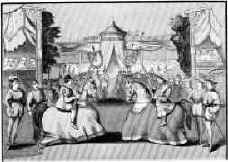
- Jousting
- Pitching the Bar
- Throwing the Sledgehammer
- Leaping
- Shin-kicking (with iron-tipped boots)
- Sword fighting
- Performing headstands
- Fox Hunting
- Hare Coursing
- Dancing to bagpipes

Tudors Entertainment: Eating
Banquets were a popular form of entertainment for the rich, but the poorer folk would also hold feasts on special occasions. If there was a great public event such as a royal wedding then the monarch would pay for wine and food to be placed in the streets for the poor people to join in the celebrations. The diners would be entertained by mummers, jugglers, jesters or fire eaters.
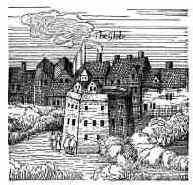
Tudors Entertainment: The Theatre
The popularity of the theatre rose with both rich and poor alike, during the sixteenth century. This popularity was helped by the rise of great playwrights such as Christopher Marlowe and William Shakespeare as well as the building of the Globe theatre in London.

Tudors Entertainment: Execution
A public execution was an event not to be missed and people would queue through the night to get the best places. There was always a carnival atmosphere and a good trade was done by pie sellers, ale merchants and producers of execution memorabilia. Public executions always produced a carnival-like atmosphere with large crowds attracting peddlers, minstrels, jugglers and other street performers anxious to use this ready-made audience.
The Tudors – Market Place
The Tudors market place was the place that the Tudors went to buy the things that they needed such as food and clothing.
People who had something to sell would set themselves and their goods in the market square and wait for people to come and buy their goods. In the picture above, the woman in blue and the woman in pink are selling baskets of fruit or vegetables, while the woman in orange has a basket of freshly baked bread for sale. In addition to fruit and vegetables, fish and meat would also be sold. It was not unusual for people to buy meat while it was still alive and only kill it when it was required.
Some people opened up the front of their houses and sold the goods from there, while others sold goods from a cart. Examples of both can be seen in the picture above. Ale would also be sold in large quantities on market day.
The money system used to buy goods was not the same as it is now. The pound was still the unit of currency, but instead of pounds and pence, the Tudors had pounds, sovereigns, crowns, half-crowns, shillings, sixpences, groats and pennies. Their values were:
- one sovereign = one pound
- one pound = twenty shillings
- one crown = five shillings
- one half-crown = two shillings and six pence
- one shilling = twelve pennies
- one sixpence = six pennies
- one groat = four pennies.
Sometimes a barter system of exchanging goods for other goods would be used instead of money.
The Tudors – Tudor Costume
Early Tudors Costume
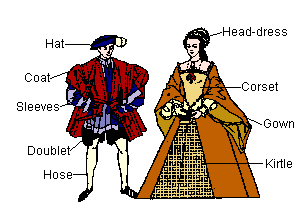
Men
Men’s clothing gave them a square shape. they wore short doublets over their hose and the shoulders of their coat were cut wide. It was fashionable for their sleeves to be slashed and their flat hats were often decorated with feathers.
Women
Women’s clothing gave them a triangular shape. Their corsets were tight fitting while their kirtles and gowns were very full. Their head-dress consisted of a coif that fitted closely round the face, to which was attached the cornet – a long piece of black material that often hung down the back.
Late Tudors Costume
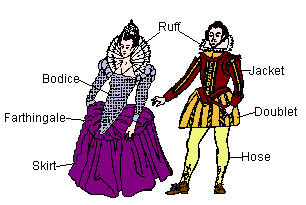
Men
The men’s fashion had not changed as much as the women’s. However, the square shape was replaced by a sleeker look. Men still wore doublet and hose, but the coat had been replaced by a short jacket. Men also wore ruffs around their necks.
Women
The style of dress had changed considerably. the bodice was longer, and the skirt was worn over a farthingale (a circular frame) to give it its unique shape. the head-dress had been replaced by jewels in the hair and an elaborate ruff of lace was worn around the neck.
Tudors Costume: Getting Dressed
Putting on an Elizabethan gown was not a simple process and, including time taken for hair and makeup, could take as long as half-an-hour. This is the order in which clothing had to be put on:
Stockings, ear rings and shoes.
Chemise – the main item of underwear.
Petticoat – for extra warmth
Farthingale- stiffened with willow to give the triangular shape to the Tudors costume.
Corset – stiffened with wood to flatten all lumps and bumps.
Bumroll – worn on the hips to give extra flare to the skirt
Parlet – worn over the corset
Kirtle – the main underskirt
Gown – split at the front to reveal the kirtle. Sleeves were either sewn in or tied on.
chemise |

petticoat |

farthingale |
corset |
bumroll |
parlet |

kirtle |

gown |
Tudors Food and Culinary Culture
Food could not be transported, nor could it be frozen. The Tudors, therefore, relied on fresh food. Beyond freshness, the sort of Tudors food consumed was largely determined by one’s social class.
The menu below shows what the wealthy would have eaten. The poor would have eaten a herb-flavored soup called pottage which would be served with bread.
However, it should be noted that there was considerable overlap in the diets of the rich and the poor. Everyone ate bread and cheese; the only difference was the quality. Low-quality bread would be made by a mixture of rye and wheat; better bread was made of wholemeal; the most expensive bread was called “archet” and made of white wheat flour.
A Sixteenth Century Dinner
 |
 |
 |
First Course
- Brawn (boar meat)
- Roast Tongue
- Leg of Pork
- Roast Beef
- Roast Venison (deer)
- Meat Pie
- Vegetables in season
- Bread
 |
 |
 |
Second Course
- Roast Lamb
- Rabbit
- Bread
- Tarts and Custard
Facts About Tudors Food
- The Tudors could keep the animals they used for food alive, so meat was available all year round.
- Fruit and vegetables could only be eaten when they were in season.
- Potatoes were not introduced to the UK until Elizabeth’s reign and then would only have been available to the rich.
- The Catholic religion of the early Tudors meant that they could not eat meat on a Friday and often not on a Wednesday. On these days fish was eaten instead.
- There was no fresh drinking water and so ale was drank with a meal. The very rich may have wine.
- Three-quarters of the Tudors diet was made up of meat – oxen, deer, calves, pigs or wild boar. They also ate a lot of chicken and other birds – pigeons and sparrows. Peacocks may have been eaten by the very rich.
- Meat was roasted, boiled or made into pies. Fish was baked, fried, grilled or boiled.
- Tudors food was served in a sauce flavored with herbs and spices.
- Bread was always served with a meal.
The Tudors – Society
Tudors society was steeped in the medieval tradition in England, yet it also embraced the changing social norms of early modern Europe. During the Tudors period people were grouped in a hierarchical system with the King at the top. The nearer to the top of the system you were, the richer you were. If you were born poor there was little chance of you becoming rich. People were taught by the church that their position in life was determined by God. However, it was through the church that some men who were born poor managed to become very rich and powerful indeed.
This diagram shows the structure of Tudors society.
The Church
During the Tudors period the church was very powerful, owning large amounts of land. The people were very religious and attended church services. The church was able to control people’s lives by preaching what they wanted them to believe. During the reign of Henry VIII the church became less powerful as Henry made himself head of the church, dissolved the monasteries and confiscated their land.
Archbishops
Archbishops were very powerful. They owned large amounts of land and were very rich. They were able to influence the King or Queen and played a part in the government of the country. After the Reformation, Archbishops only remained powerful if they supported the monarch.
Bishops
The Bishops of the most important churches were rich and powerful, playing a part in the government of the country. After the Reformation they only remained in position if they supported their monarch.
Clergymen
Clergymen were poorly paid but were highly respected members of the community that they served. As well as delivering church services they were responsible for the education of those members of the community that could afford to pay, for visiting the sick and counselling the bereaved.
The King or Queen
The Tudors monarch was at the head of the social system. He or she was the richest person in the land, owning vast amounts of land and many palaces. Both rich and poor alike were bound to serve their monarch, failure to do so often resulted in death. The monarch made all the laws of the land and although there was a court system, few judges would dare to pass judgement against the King’s wishes. Until Henry VIII broke away from Rome (the Reformation) and formed the Church of England, Monarchs were subject to obey the Pope. The Tudors monarchs, with the exception of Henry VII, and Mary I who returned the Church to Rome, were head of the Church, the Judiciary and the Government.
Gentlemen
Gentlemen were born rich and came from families with titles – Barons, Earls and Dukes. Most owned large country estates and were often given important positions in government. The Monarch would visit his most notable subjects when he or she went on a progress and they would be expected to provide board and lodging for the King and his court. Sometimes this could be as many as 300 persons. If summoned to court a gentleman, or other member of his family, would have to leave their home and travel to London to be with the King.
Yeomen and Citizens
Both yeomen and citizens were fairly wealthy men. They were not born members of the gentry, but were rich enough to own their own houses and employ servants. Yeomen either owned their own land or rented land from gentlemen which they farmed. They were successful farmers and were rich enough to be able to afford labourers to do the heavy farming jobs for them. Citizens lived in the towns. They were rich merchants and craftsmen. Merchants made their living by trading goods with ship owners. Craftsmen were skilled men who could command a good price for the goods that they made.
Labourers
Labourers worked for Yeomen or citizens and were paid a wage for their work. Labourers were employed to do the heavy back-breaking jobs on the farms or in the craft shops. In 1515 an act was passed which fixed a labourers wage at 3d per day for winter months and 4d per day for summer months with bonuses to be paid at harvest time. A labourer could expect to work from sunrise to sunset in the winter and from sunrise to early evening in the summer. Sundays and major saint’s days were free. Skilled workers were to be paid 5d per day during the winter and 6d for summer days.
Vagrants/Beggars
These formed the lowest and poorest section of the Tudors social system. They did not work and therefore earned no money. They were forced to beg on the streets for money or food. In 1536 laws were introduced that punished those who could work but chose not to (undeserving poor). The Church helped those who were unable to work due to ill health or disability.
The Tudors – Monarchs
The Tudors monarchs reigned from 1485 until 1603. There were five crowned Tudors monarchs; Lady Jane Grey reigned as Queen for only nine days. The Tudors kings and queens were very powerful and they are noted for the numbers of people executed during the period.
 |
Henry VII came to the throne after defeating Richard III at the Battle of Bosworth Field in 1485. He was a serious man and faced many challenges to his place on the throne, the most notable being from Lambert Simnel and Perkin Warbeck. He married Elizabeth of York, daughter of Edward IV uniting the houses of Lancaster and York and ending the Wars of the Roses. Henry successfully established the Tudors dynasty and when he died in 1509, his son’s succession was not challenged and England was a rich and prosperous country. |
 |
Henry VIII is the best known of the Tudors Monarchs, he was the second son of Henry VII and became King because his brother, Arthur had died. He married his brother’s widow, Catherine of Aragon when he became King, but divorced her when she did not produce a male heir to the throne. In order to gain his divorce, Henry had to establish the Church of England and end Catholicism. Henry went on to marry another five wives – Anne Boleyn, Jane Seymour, Anne of Cleves, Katherine Howard and Katherine Parr. Anne Boleyn and Katherine Howard were executed for treason. He died in 1547. |
 |
Edward VI came to the throne at the age of 9 years. He was a sickly child and the country was run by his protectors: firstly, the Duke of Somerset, his mother’s brother, then by the Duke of Northumberland. Edward died at the age of 15 in 1553. |
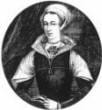 |
Lady Jane Grey was chosen to be Queen by the Duke of Northumberland in an attempt to keep England a Protestant country. Next in the line of succession was Henry VIII’s eldest daughter, Mary. Mary was a Catholic and had sworn to return England to Catholicism. The public did not approve of Jane’s succession and supported Mary’s claim to the throne. Queen Jane reigned for just 9 days before Mary successfully took the throne. Jane and her husband, Guildford Dudley, son of the Duke of Northumberland, were beheaded. |
 |
Mary I was the daughter of Henry VIII and Catherine of Aragon and was a committed Catholic. When she came to the throne she vowed to return England to Rome and Catholicism. She is known as Bloody Mary because of the numbers of people who were executed for being Protestants. She made herself even more unpopular by marrying Philip of Spain and losing Calais, England’s last possession in France. Mary died in 1558, probably of cancer of the womb. |
 |
Elizabeth I became Queen after her sister Mary I died without an heir. She was the daughter of Henry VIII and Anne Boleyn. She upheld Protestantism in England and her will was the law. She did not marry and was known as the Virgin Queen. During Elizabeth’s reign the age of exploration began with explorers such as Francis Drake claiming new lands for England and introducing new materials and foods. The American State, Virginia, is named after her. When Elizabeth died in 1603 the Tudor line ended. |
The War of the Roses History
The War of the Roses history is a story of Tudors monarchs desperately attempting to unite a faction behind them large enough to unite the fledging realm of England. Henry VII (1457 – 1509) was the first Tudors monarch. His claim to the throne was not strong and he became king after defeating Richard III at the Battle of Bosworth Field in 1485.
Henry’s success on the battlefield ended the Wars of the Roses that had begun in 1455. The Wars of the Roses were a series of battles that were fought between the supporters of the House of Lancaster (Lancastrians) and the supporters of the House of York (Yorkists).
The wars were called the Wars of the Roses because the Yorkists were represented by a white rose and the Lancastrians by a red rose.
Background to the Wars of the Roses
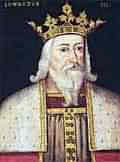
Although there were no battles fought until 1455, the cause of the wars dates back to the reign of Edward III and the power struggle between his sons after his death.
The four eldest sons of Edward III (1312 – 1377) were Edward the Black Prince (heir to the throne), Lionel of Antwerp (Duke of Clarence) John of Gaunt (Duke of Lancaster) and Edmund of Langley (Duke of York)
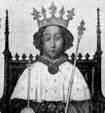
Edward III died in 1377. His eldest son, Edward, the Black Prince had died of the plague in 1376 and so his grandson, Richard, aged ten and son of the Black Prince, became king. Because Richard II was only ten years old, his uncle, John of Gaunt, Duke of Lancaster, ruled the country. As Richard grew older he rebelled against his uncle and made decisions that were not popular with the most powerful men in the country.
In 1399 John of Gaunt died and Richard II confiscated the land he had owned. John of Gaunt’s son, Henry, raised an army and when Richard surrendered took the throne as Henry IV. Richard was imprisoned in Pontefract castle and mysteriously died in February 1400.
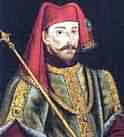
Henry IV faced a number of challenges to his place on the throne because he was not the natural successor to Richard II. With the death of Richard II, the crown should have passed to Edmund Earl of March, great grandson of Lionel Duke of Clarence. However, Henry managed to keep his place on the throne and when he died in 1413, the country was at peace and his son, Henry V, succeeded without problem.
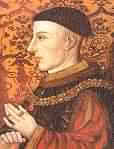
Henry V was a strong leader and after ordering the execution of Richard, Earl of Cambridge for plotting to put the Yorkists on the throne, invaded France. He won many battles, including the Battle of Agincourt in 1415 and conquered Normandy and Rouen for England. In 1420, Henry married the daughter of the king of France and it was agreed that their children would be the heirs of both England and France. When Henry V died in 1422 from dysentery, his son, Henry VI became the only king to be crowned king of England and France.
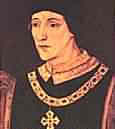
Henry VI was four months old when he became king and his father’s brothers ruled England and France in his place. France was soon lost when Joan of Arc raised an army against the English and restored the French monarchy. As Henry grew older it became apparent that he was a weak king, totally dominated by his French wife Margaret of Anjou. He was also prone to bouts of insanity and the Yorkists began plotting to take his place on the throne.
The first battle of the Wars of the Roses took place at St Albans on 22nd May 1455. The Yorkists led by Richard Duke of York easily defeated the King’s army. Henry VI was injured and taken prisoner. In 1455, Henry suffered another bout of insanity and Richard Duke of York was made protector of England. In 1456, Henry recovered and retook the throne. There were further battles and in 1459 Richard was killed at the Battle of Wakefield.
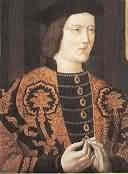
In 1461, Richard’s son Edward, Earl of March, defeated the King’s army, took the King prisoner and made himself King Edward IV. Queen Margaret took her son and fled to Wales where they were taken in by the king’s half-brother Jaspar Tudor. In 1470, Henry regained the throne but in 1471 was defeated by Edward’s army at the Battle of Tewkesbury and taken prisoner. Henry’s son, Edward, Prince of Wales was killed during the battle. With no other Lancastrian heir to challenge him, Edward IV remained king until his sudden death in 1483.
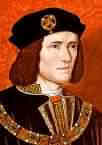
Edward IV had two sons, Edward and Richard, both of whom were too young to rule and so their uncle Richard Duke of Gloucester ruled England. The two princes were taken to the Tower of London and in the summer of 1483 mysteriously disappeared. It is believed that their uncle murdered them. Richard was crowned Richard III. He was not a popular king and faced many challenges to his place on the throne, notably from Henry Tudor, grandson of Owen Tudor who had been second husband to Henry V’s wife Katherine of Valois.
Henry Tudor raised a Lancastrian army against Richard Iii and at the Battle of Bosworth Field in 1485, Richard was killed and the Yorkists defeated. It is told that Henry found Richard’s crown on the battlefield and placed it on his head. Henry VII was crowned king and married Edward IV’s daughter, Elizabeth of York a move that was to end the Wars of the Roses.

The Red Rose of Lancaster + The White Rose of York = The Red and White Tudor Rose
This article is part of our larger selection of posts about the Tudor Dynasty. To learn more, click here for our comprehensive guide to the Tudor Dynasty.
The Tudors – Bibliography
Anne Boleyn – Tudor History
Anne of Cleves – Tudor History
Catherine of Aragon – Tudor History
Edward VI – Britannia
Edward VI – Tudor History
Lady Jane Grey – Jane Lambert
Elizabeth I – Anniina Jokinen
Elizabeth I – Tudor History
Elizabethan Costume – Drea Leed
Henry VII – Britannia
Henry VII – The History Net
Henry VII – Tudor History
Henry VIII – Britannia
Henry VIII – Tudor History
Jane Grey – Tudor History
Jane Seymour – Tudor History
Katherine Parr – Tudor History
Kathryn Howard – Tudor History
Life in Tudor Times – Nettlesworth Primary School
Mary I – Tudor History
Mary I – Elizabeth Lee
Reformation Europe – Internet Modern History Sourcebook
Suppression of the English Monasteries under Henry VIII – Catholic Encyclopedia
The Life and Times of Queen Elizabeth I – Heather Thomas
Tudor Food – Tudor History
Tudor Fun and Games – Nettlesworth Primary School
Who’s Who in Tudor History – Tudor History
Cite This Article
"The Tudors – Overview of the Royal Dynasty" History on the Net© 2000-2024, Salem Media.
April 27, 2024 <https://www.historyonthenet.com/tudors-overview-of-tudors-dynasty-of-royal-history>
More Citation Information.



